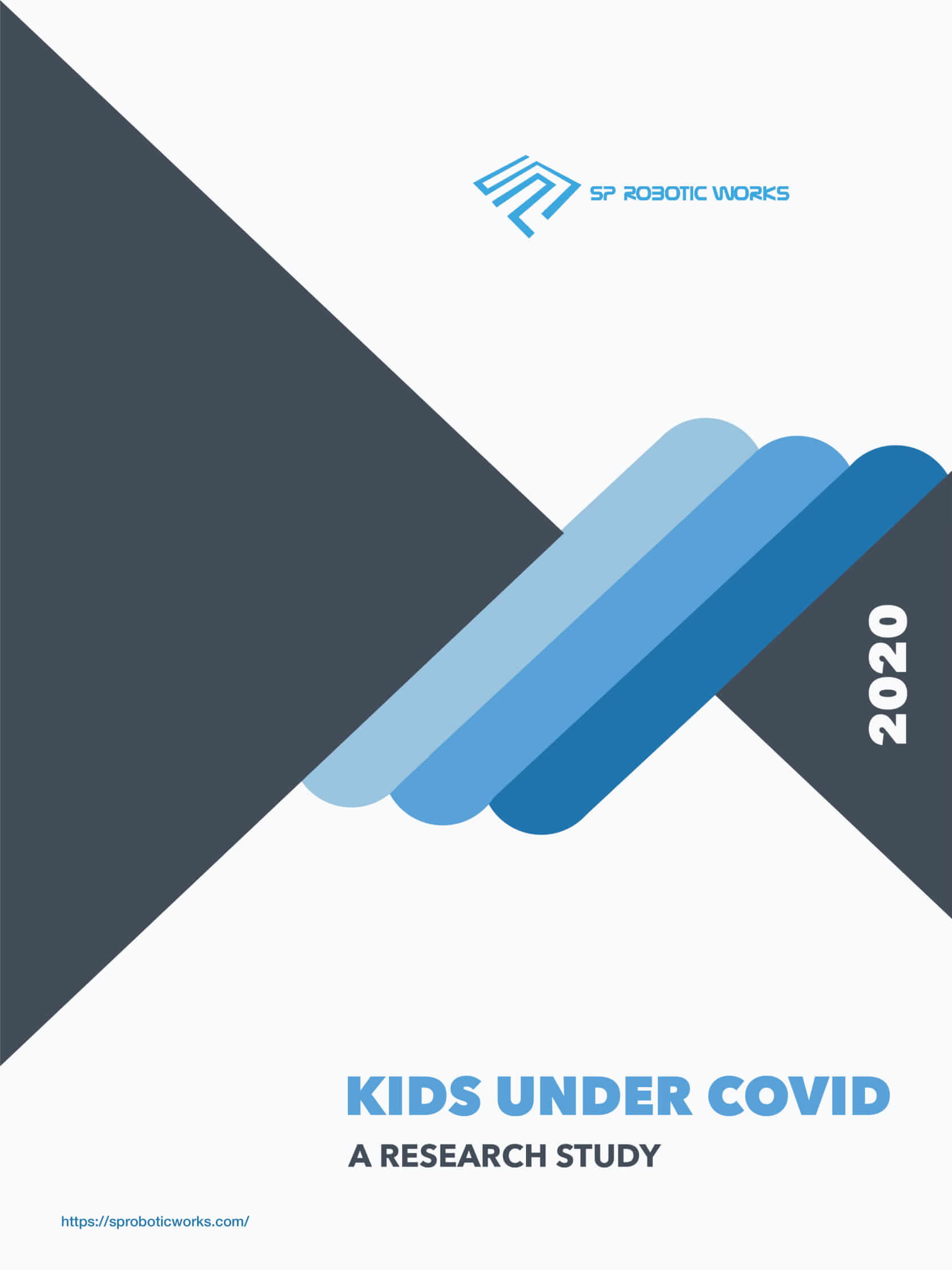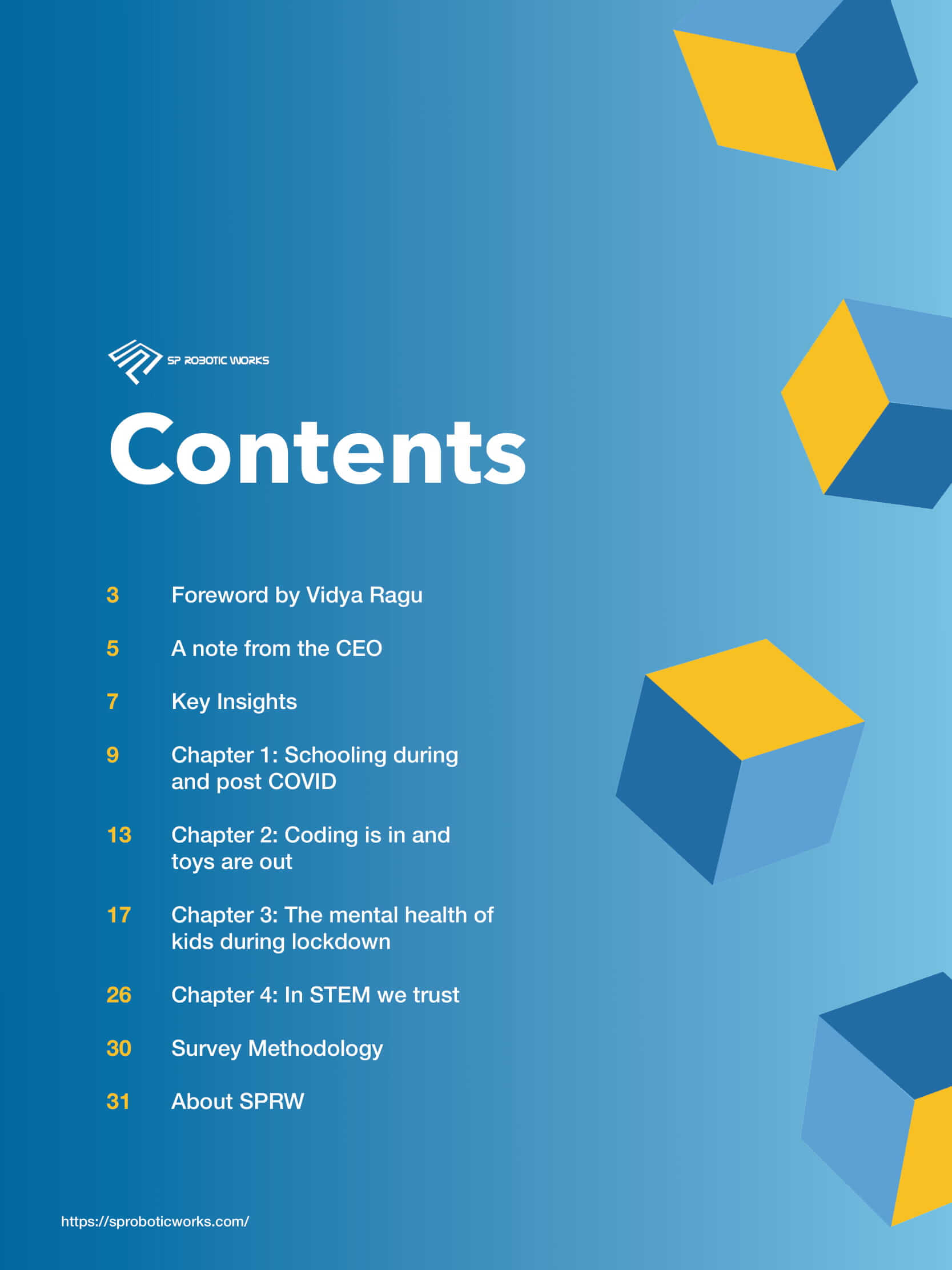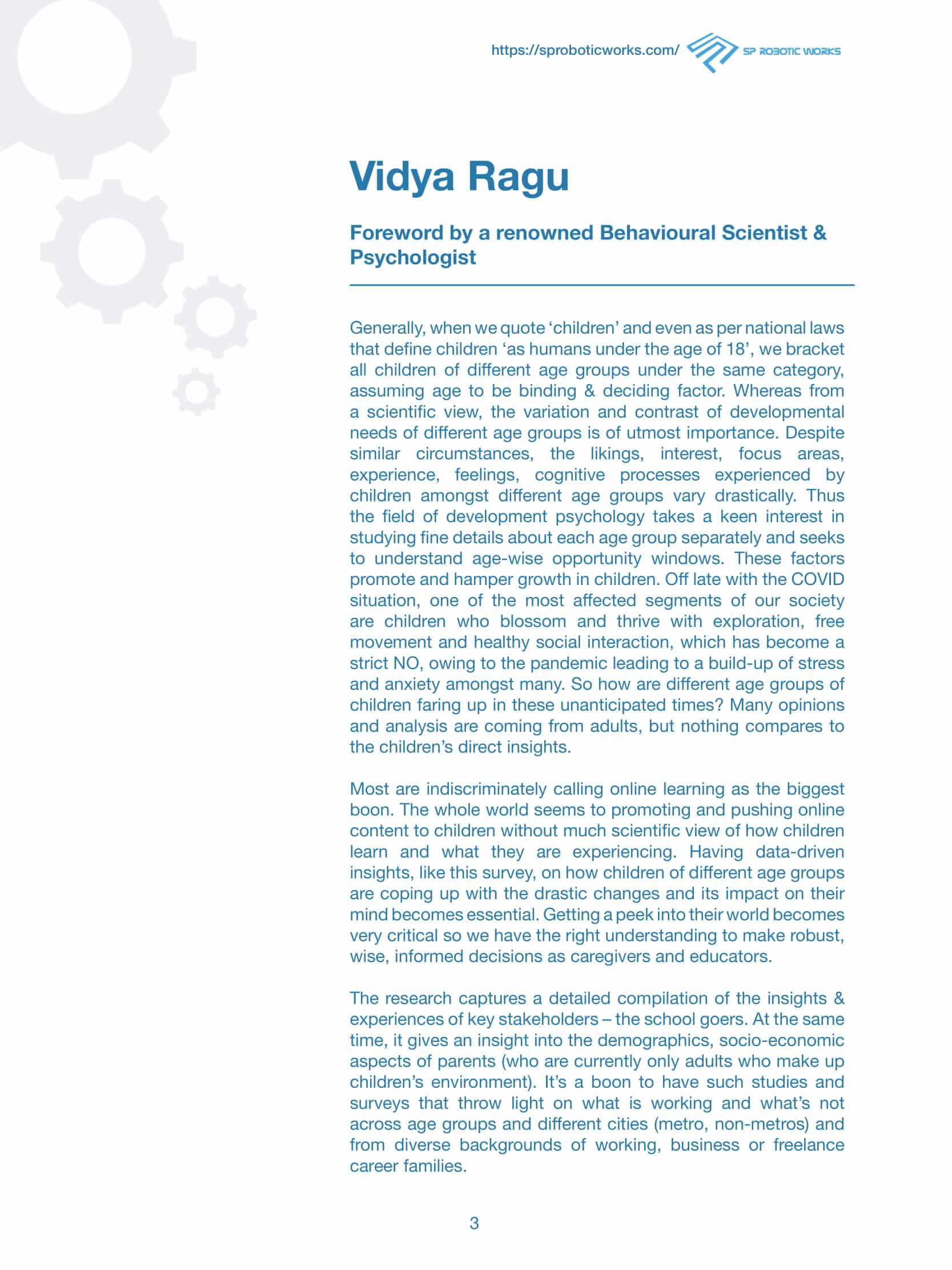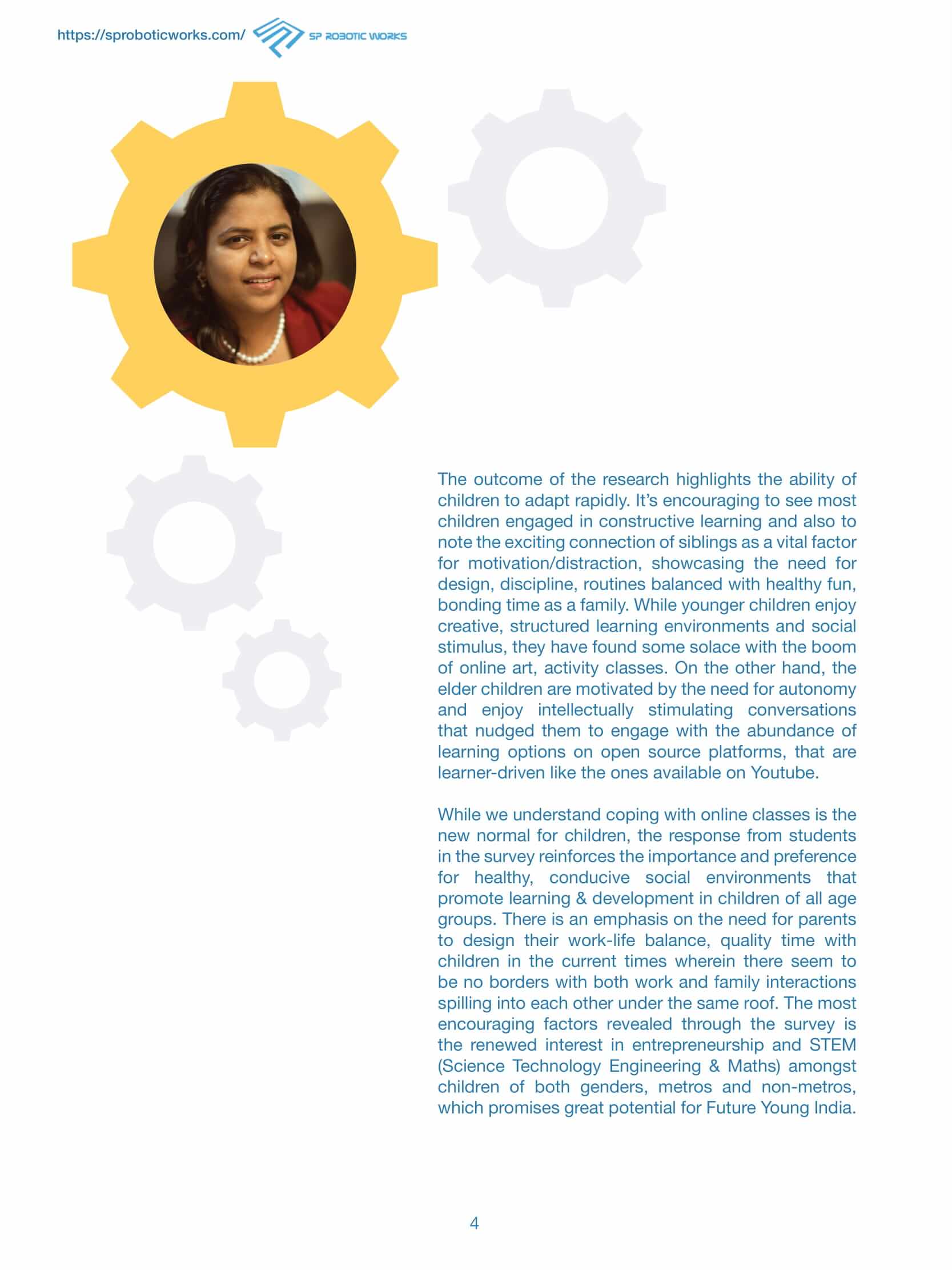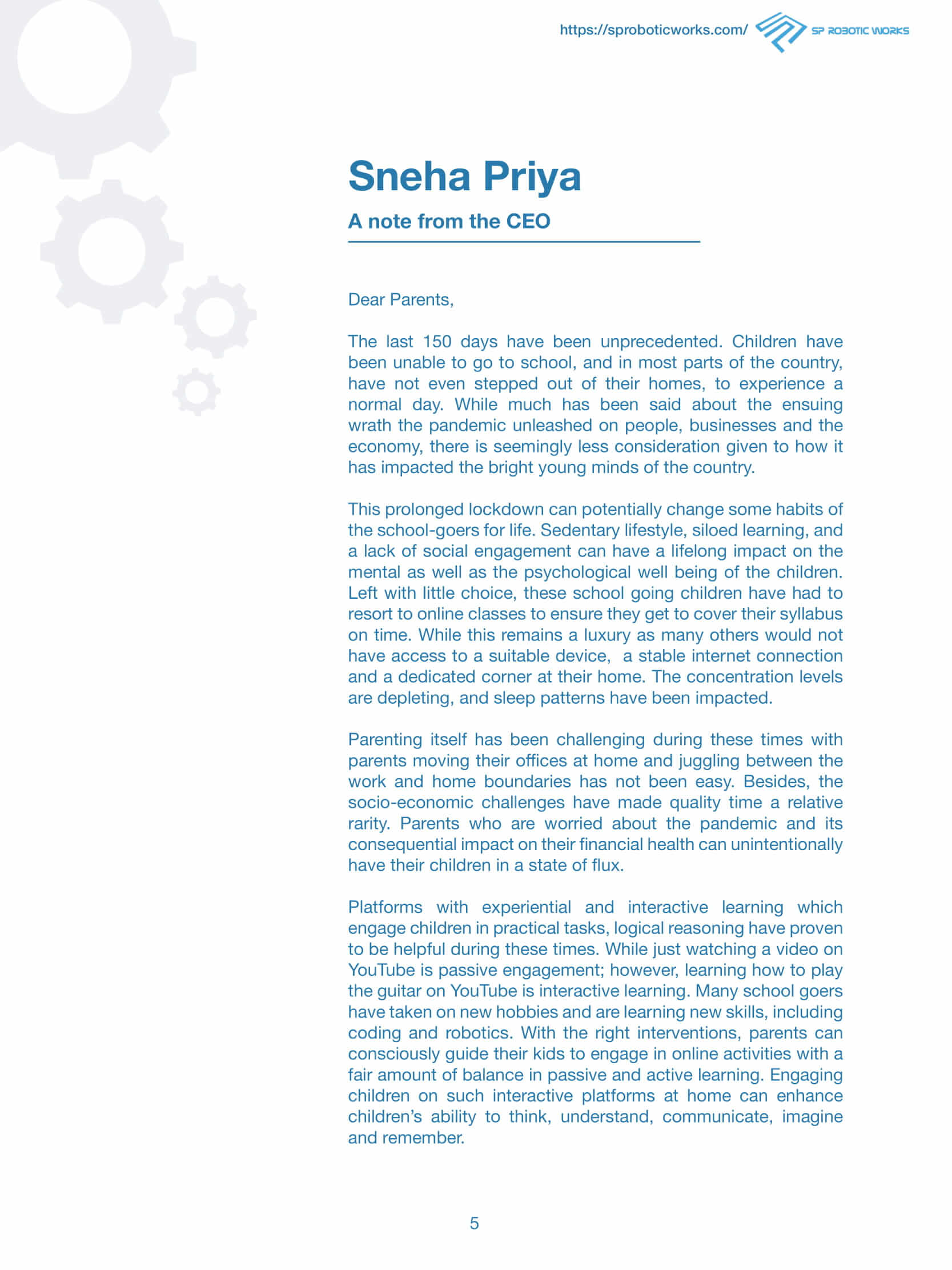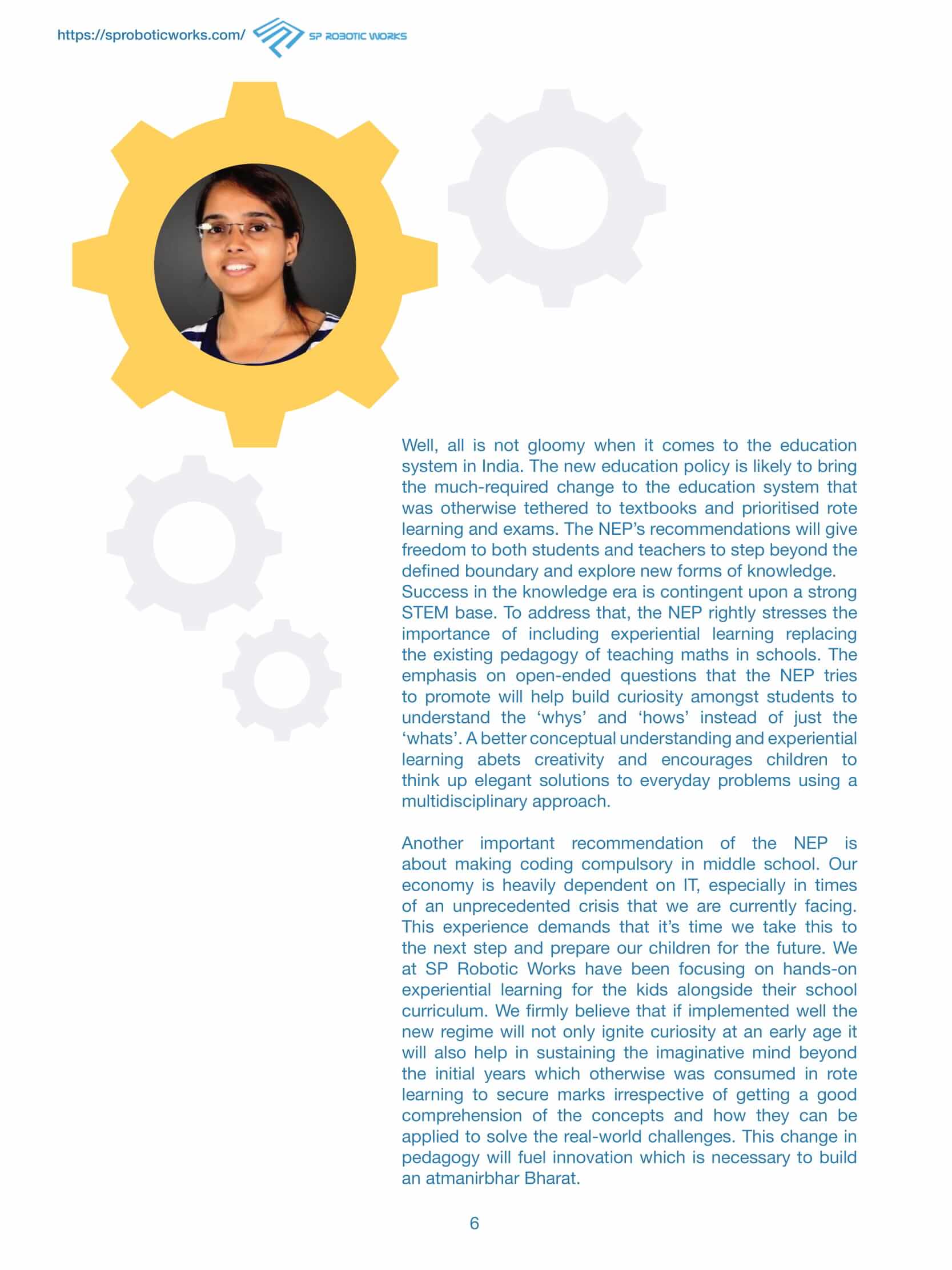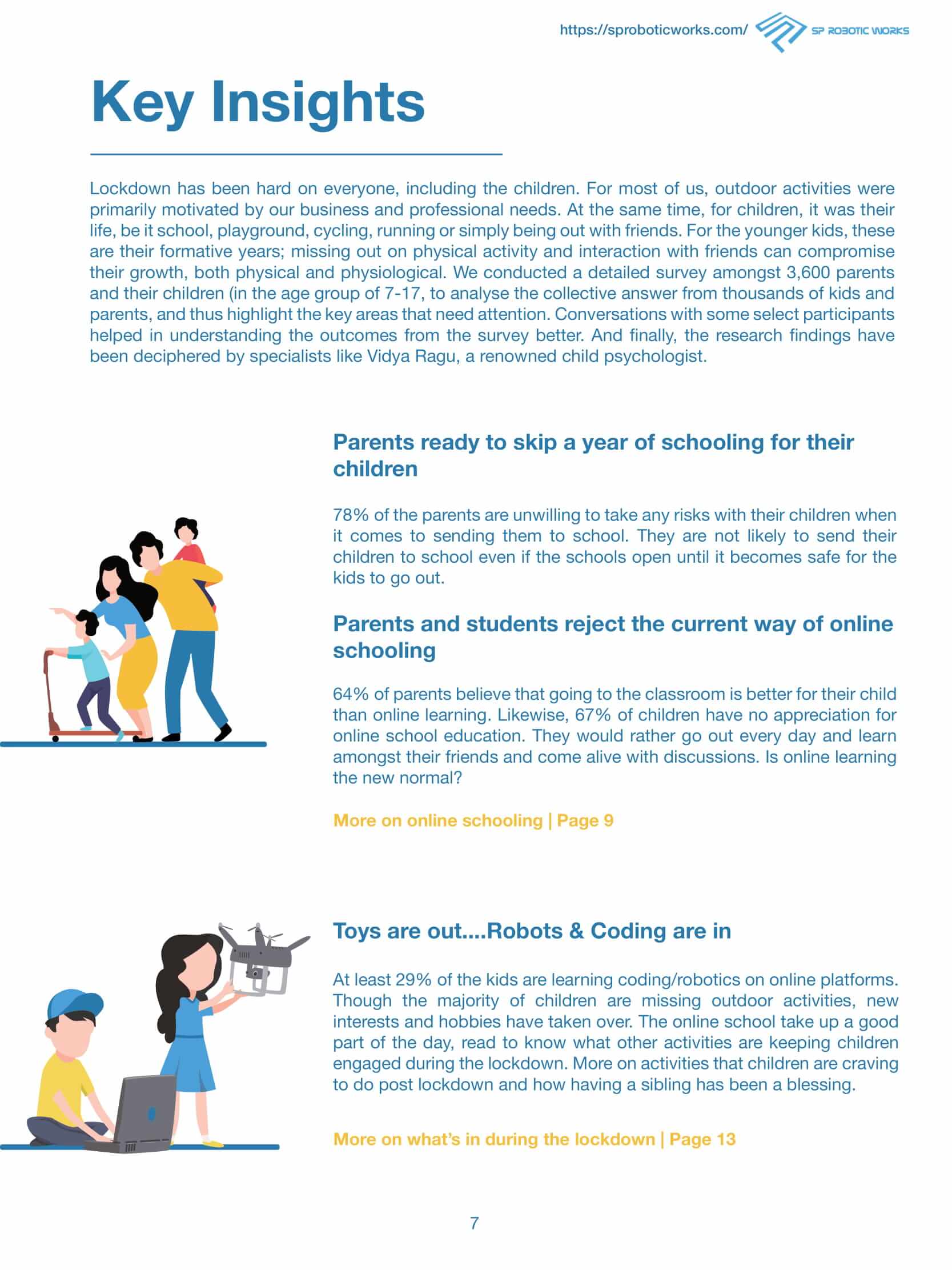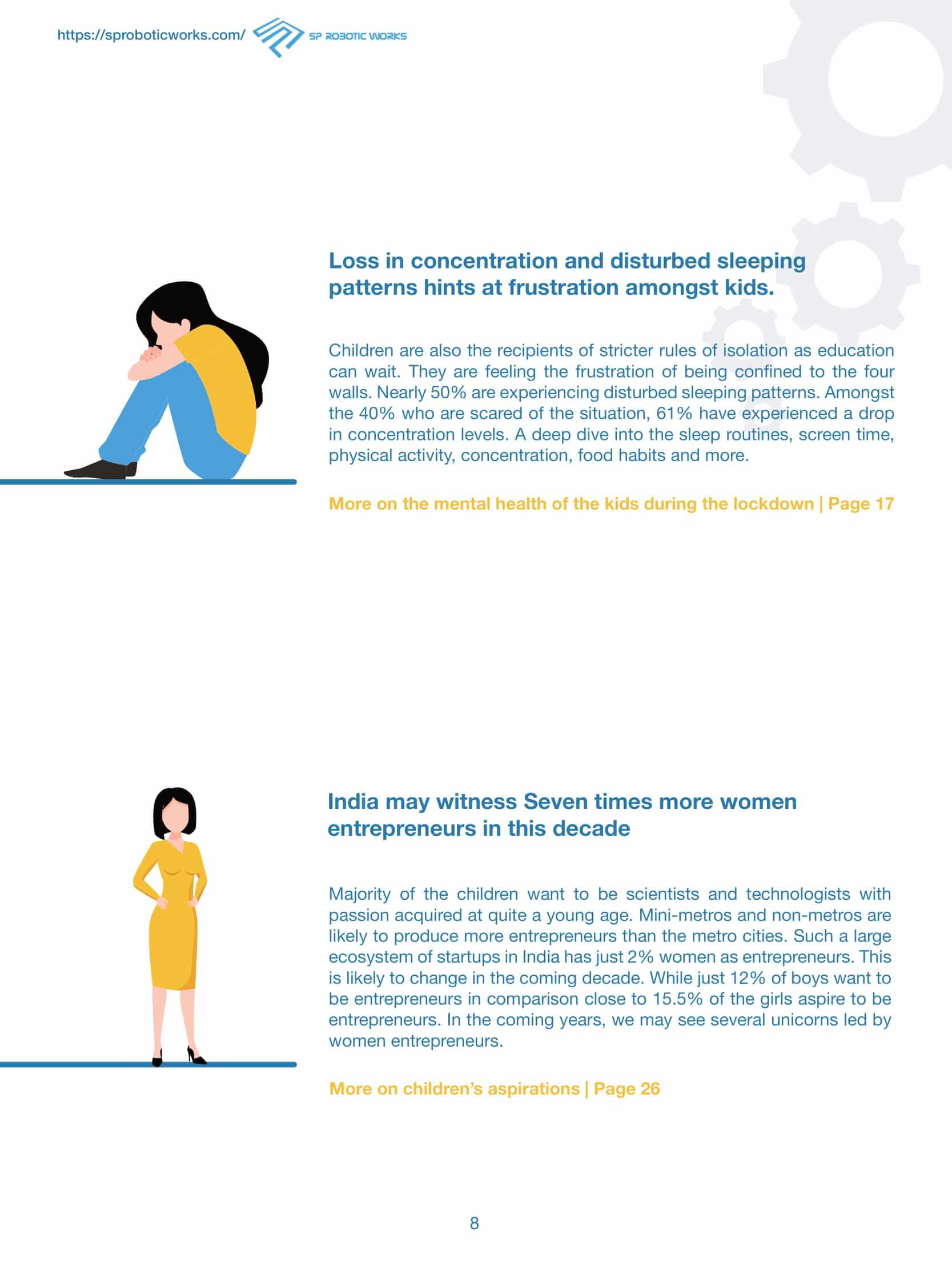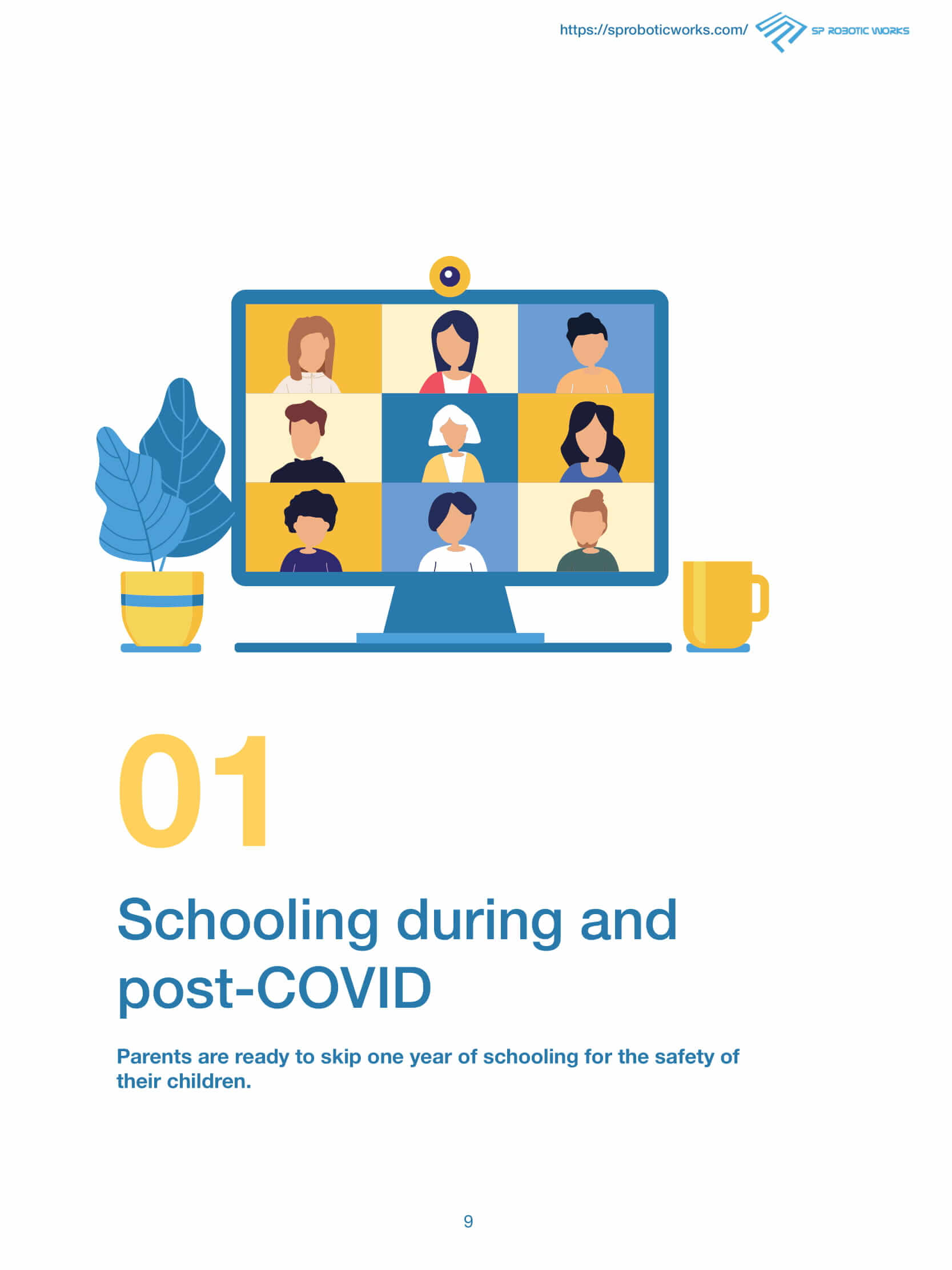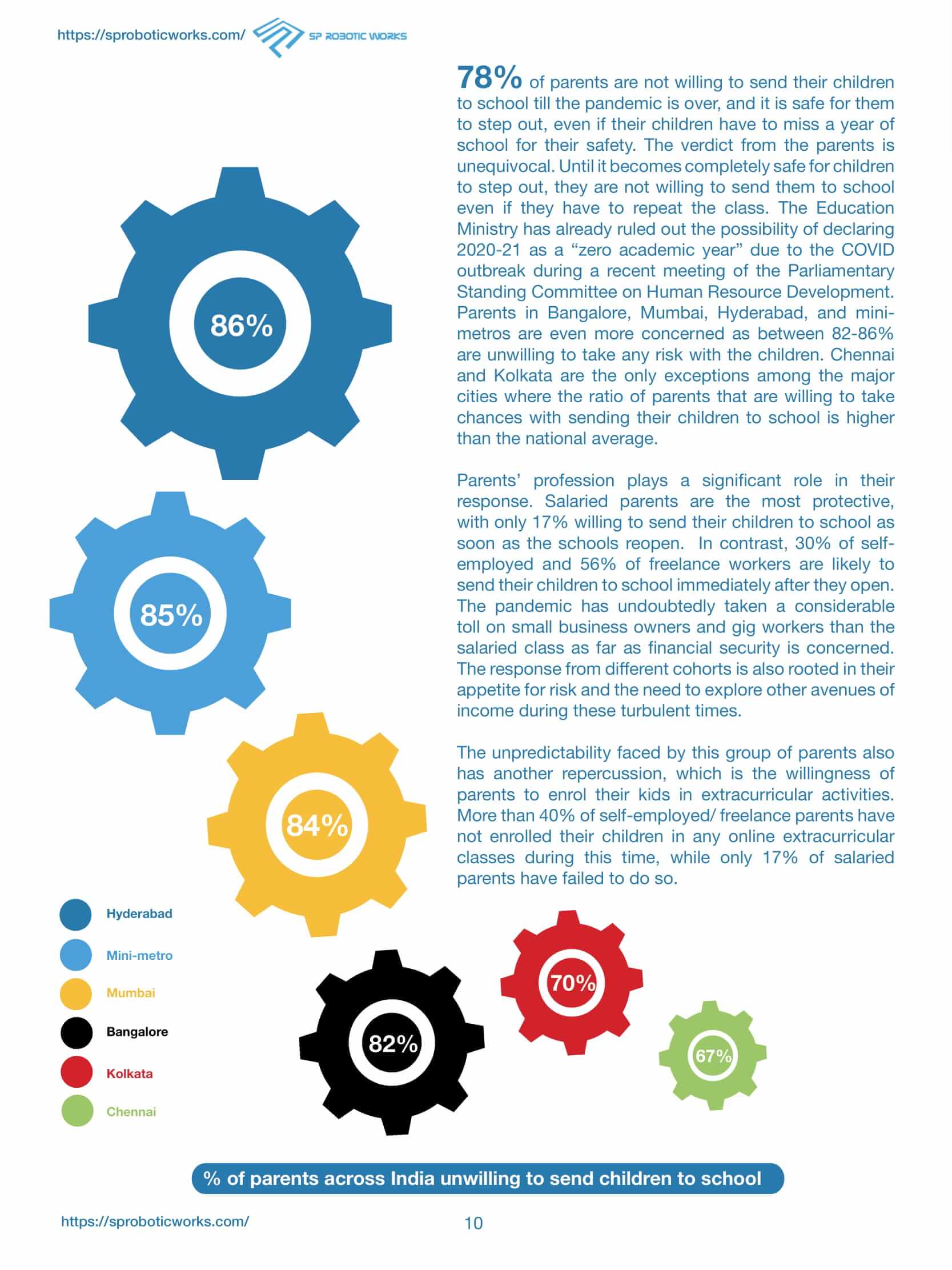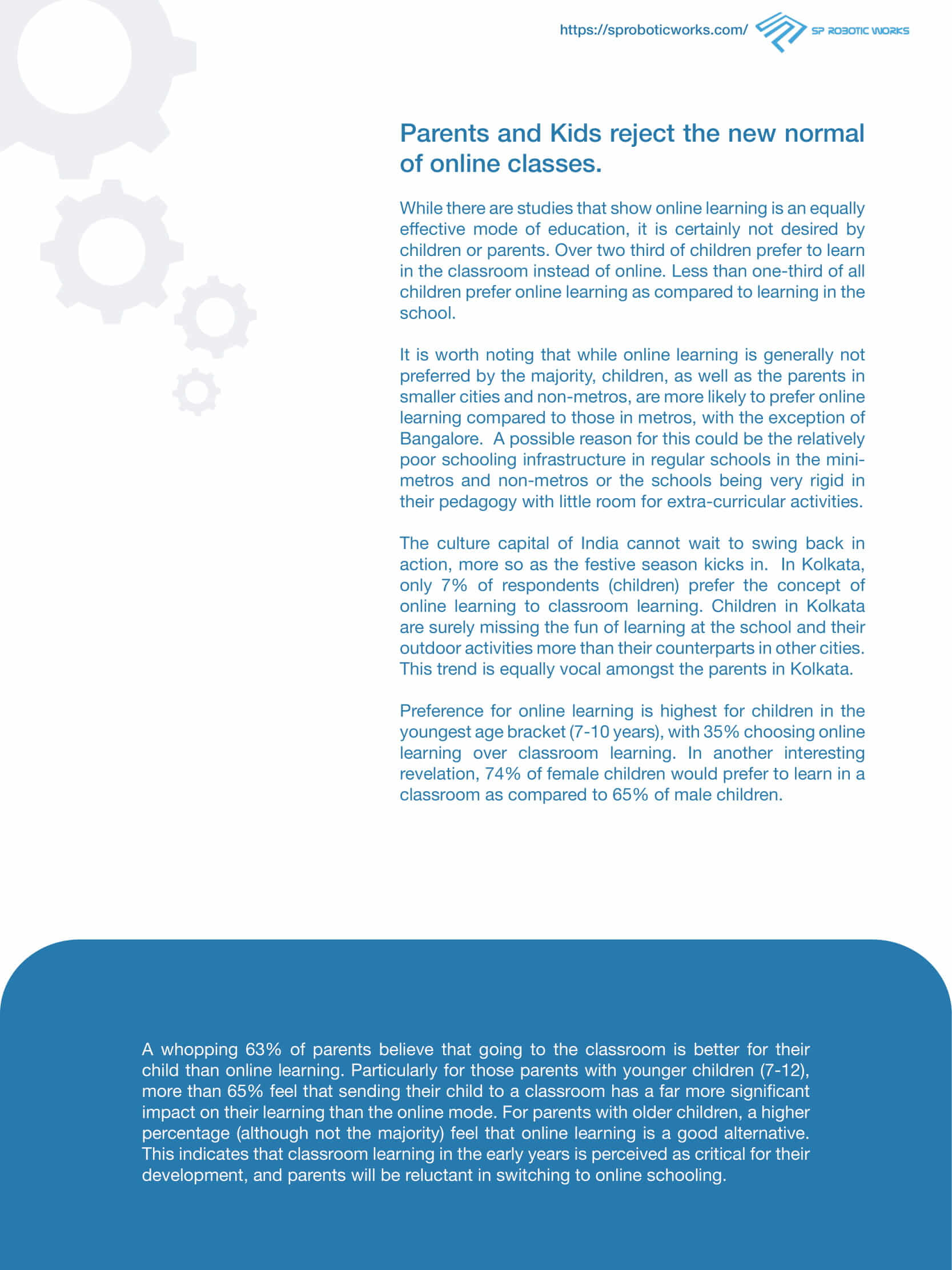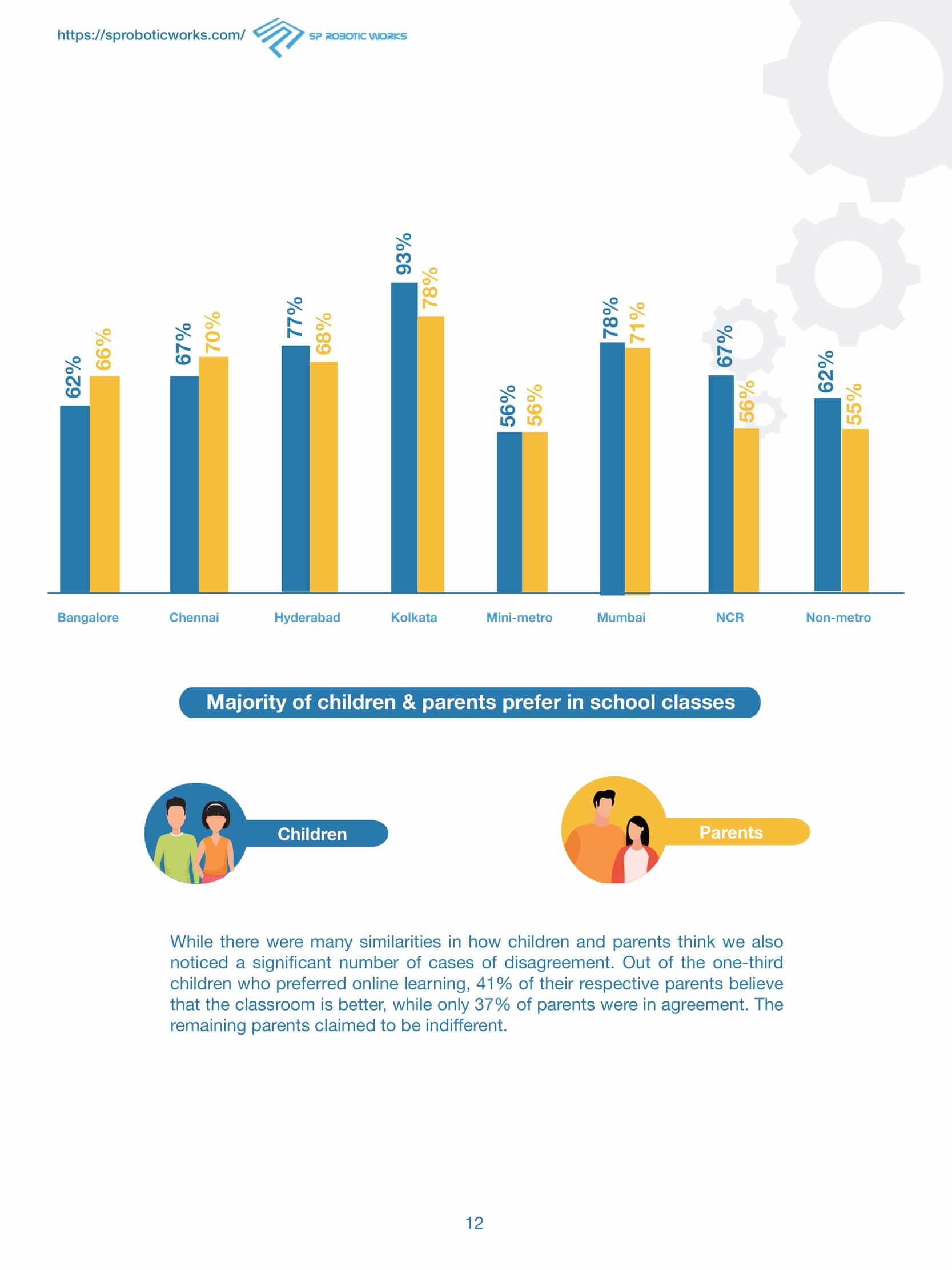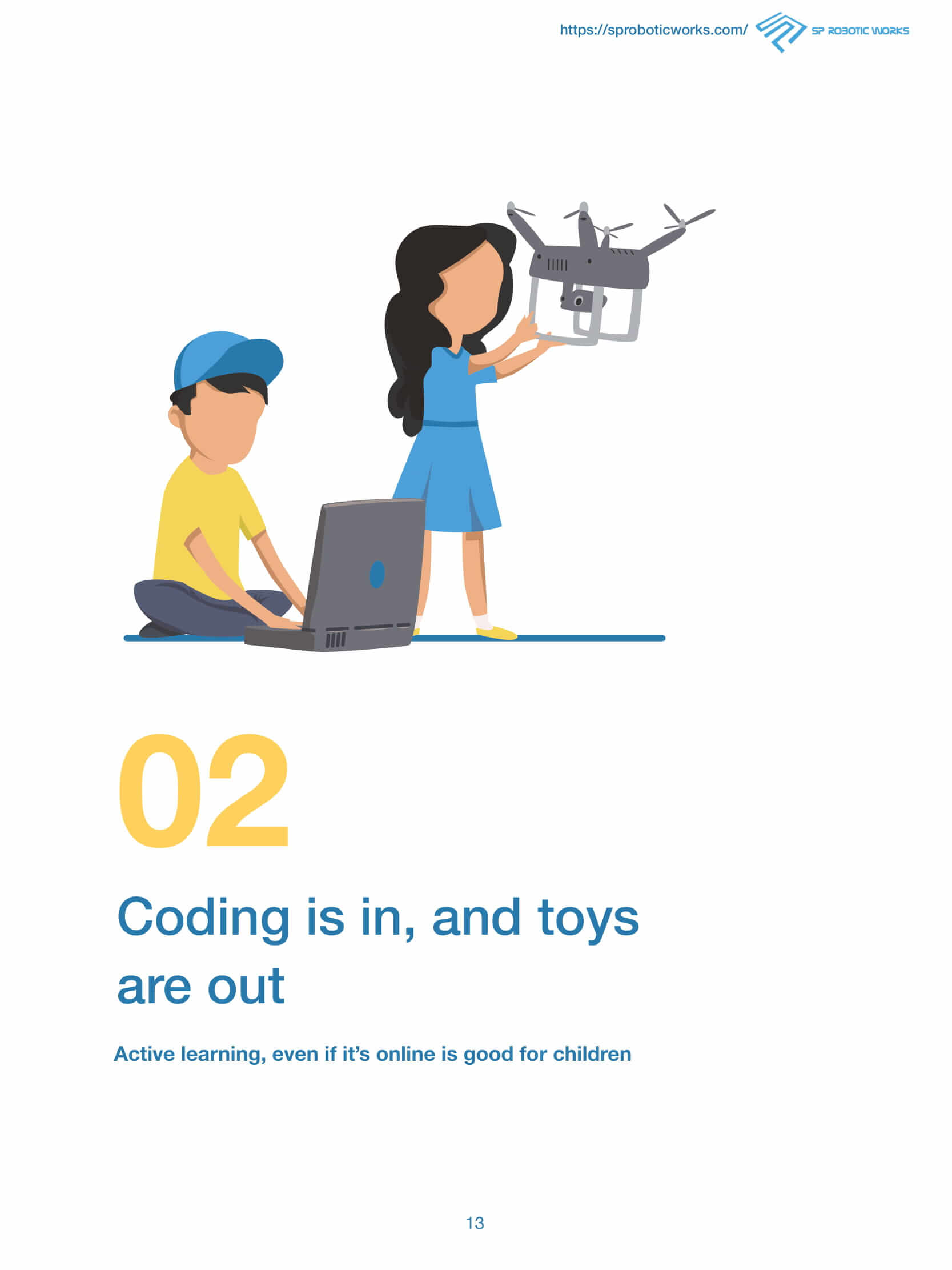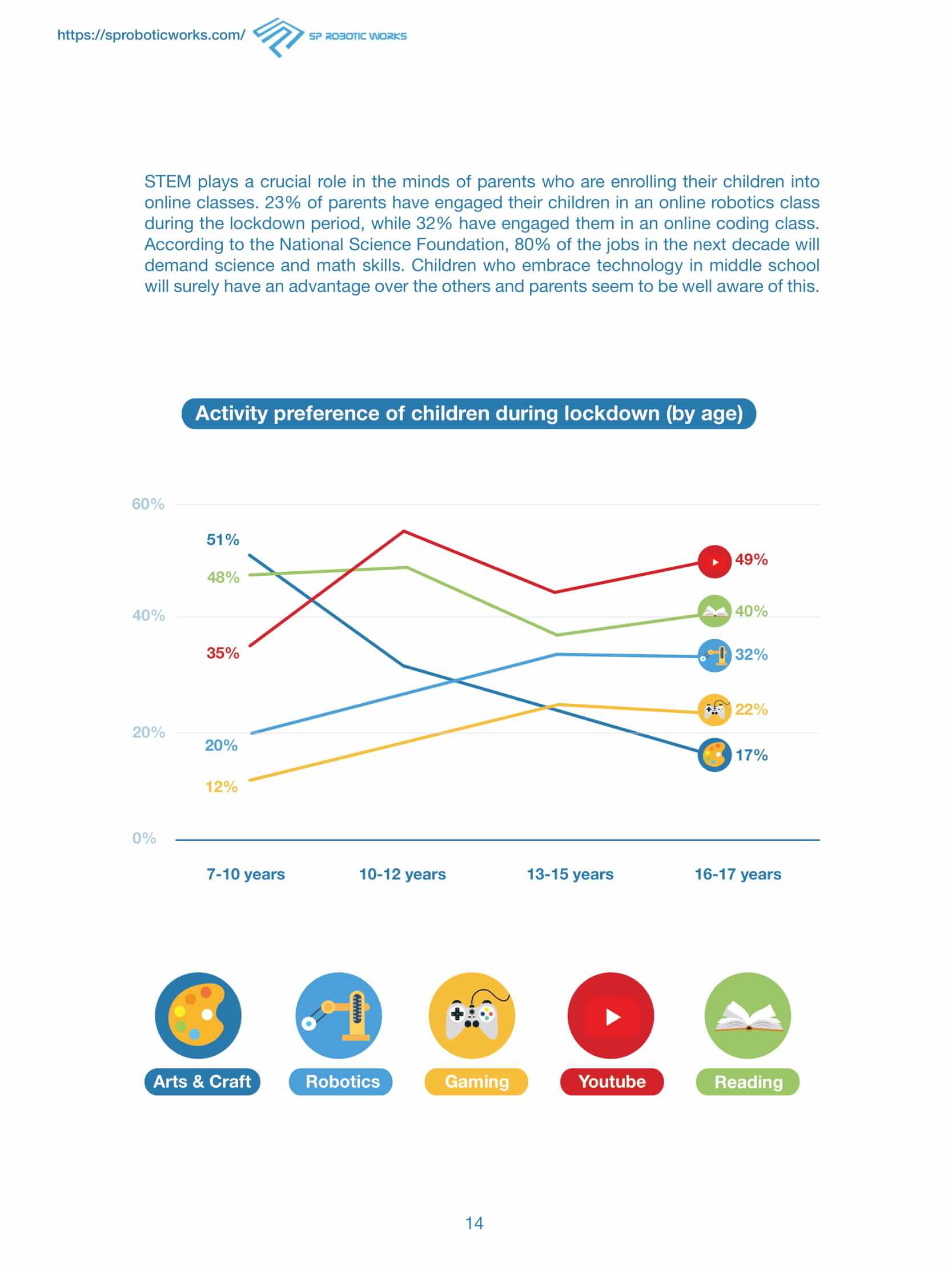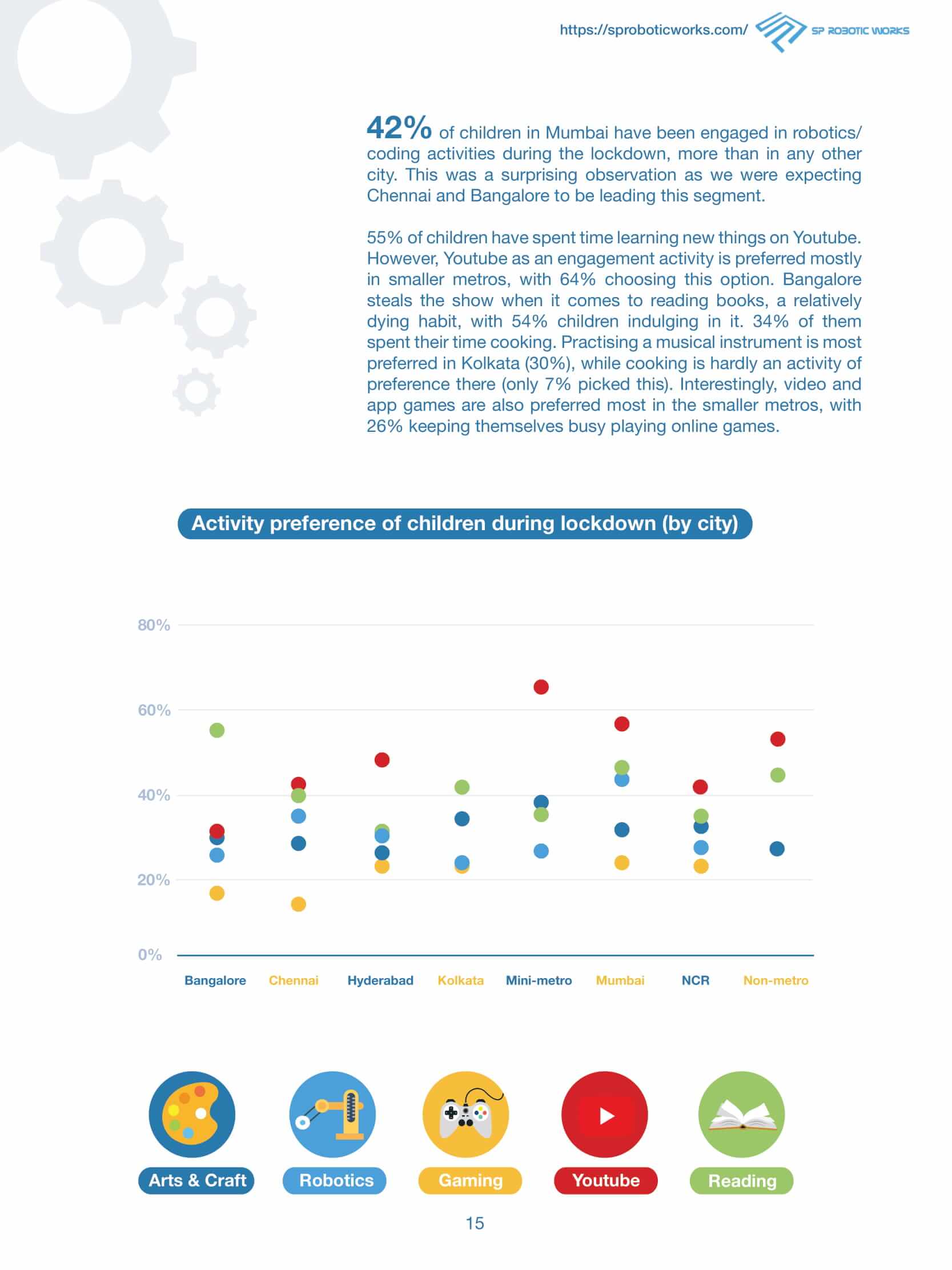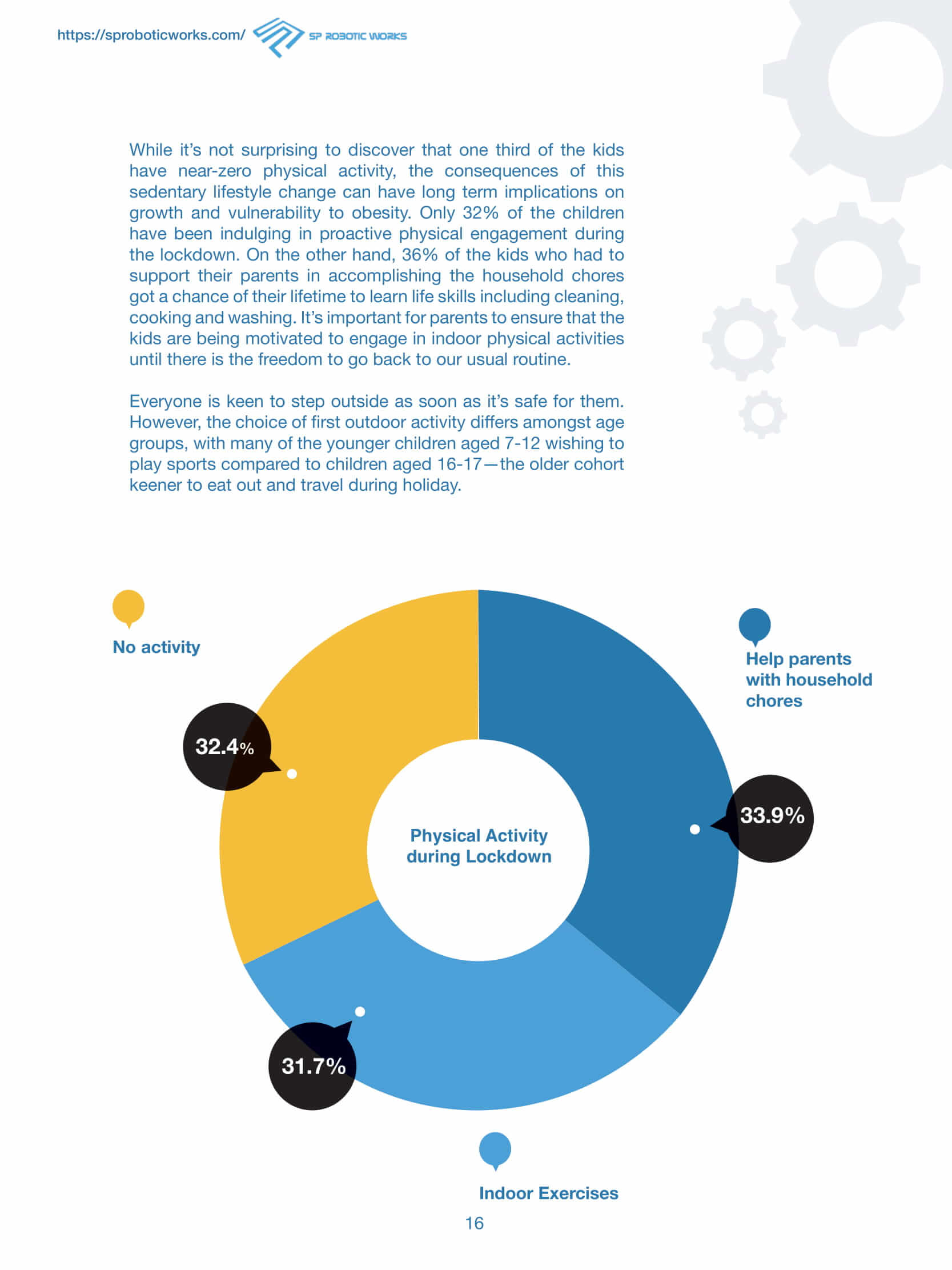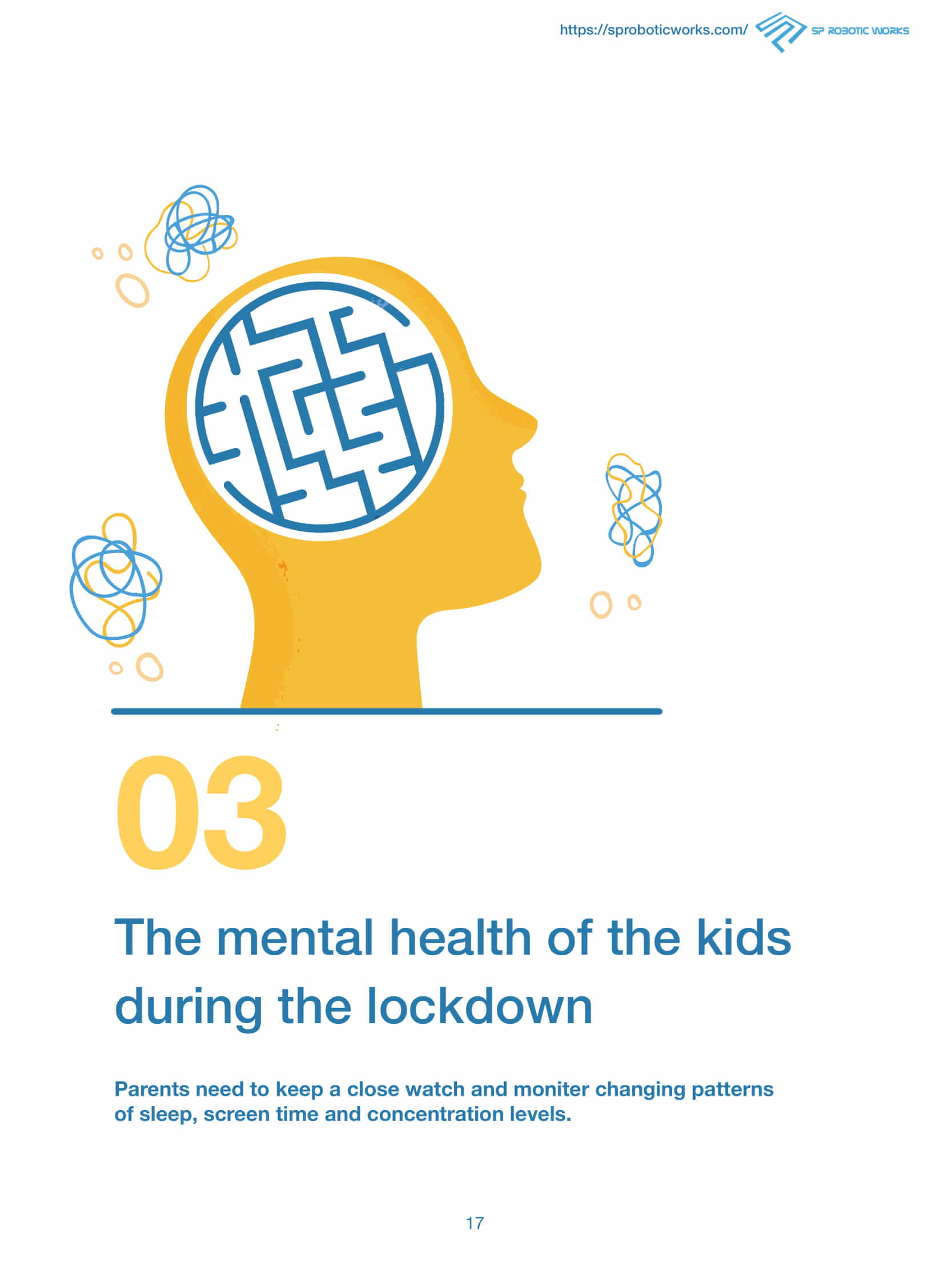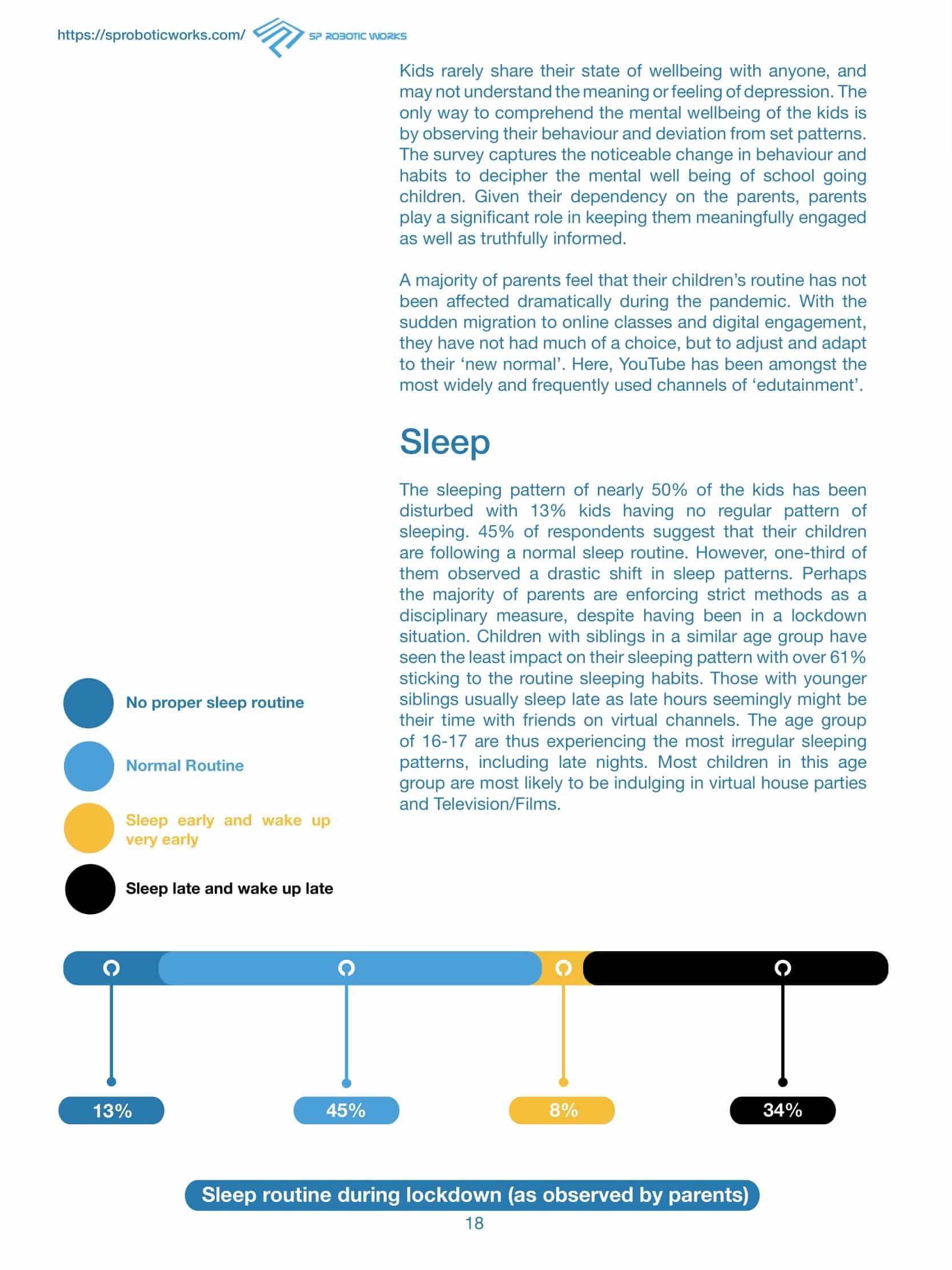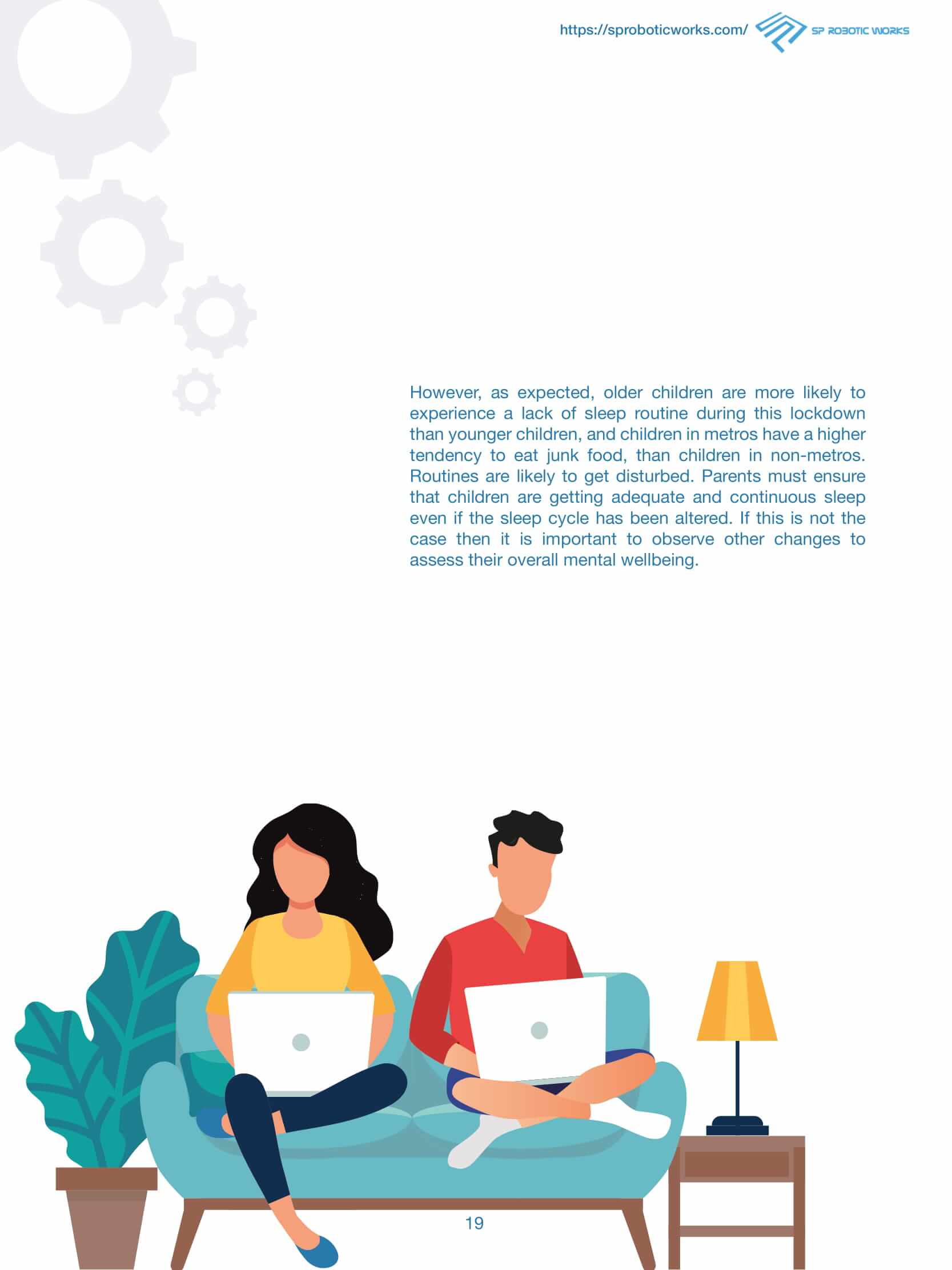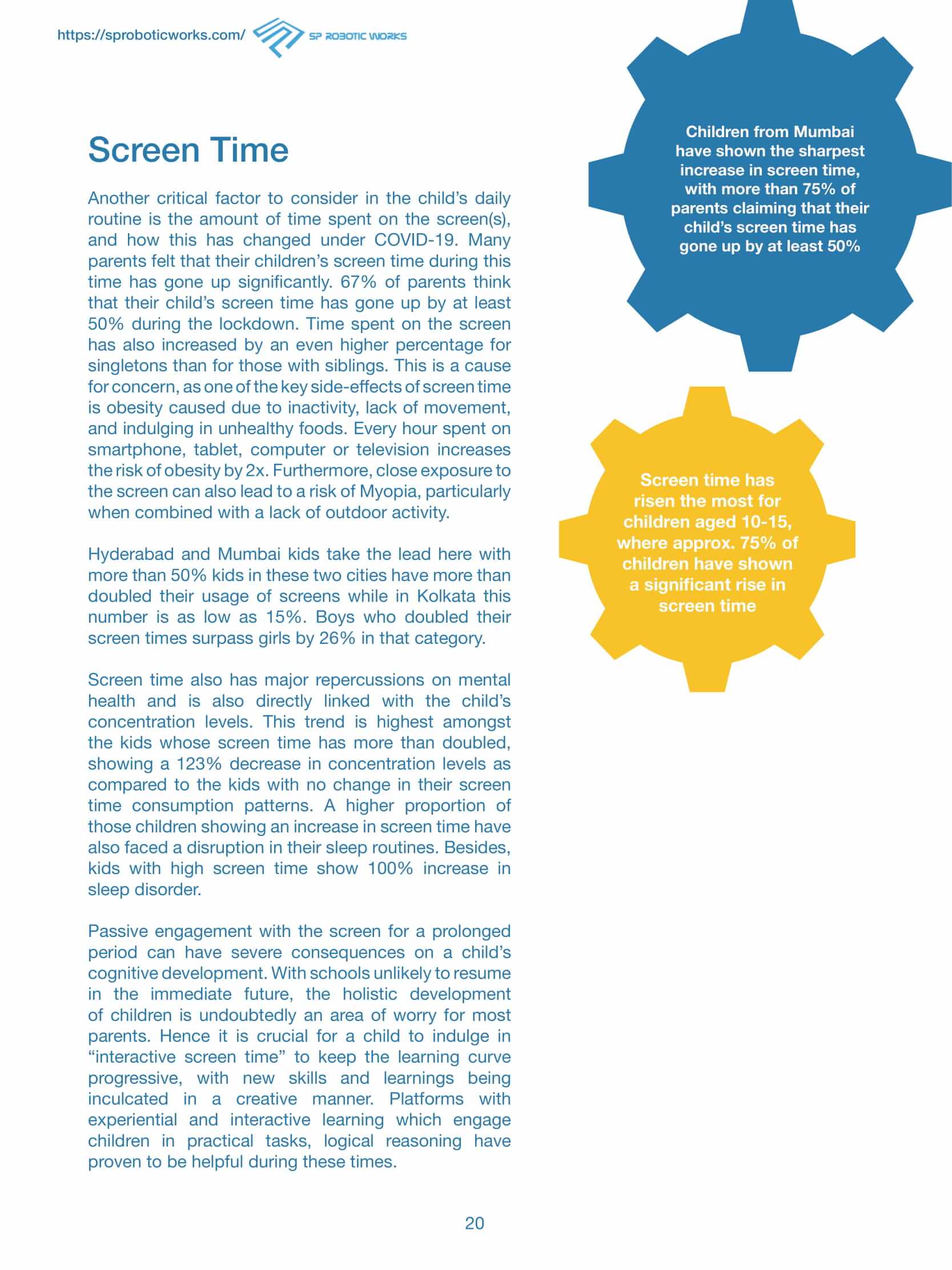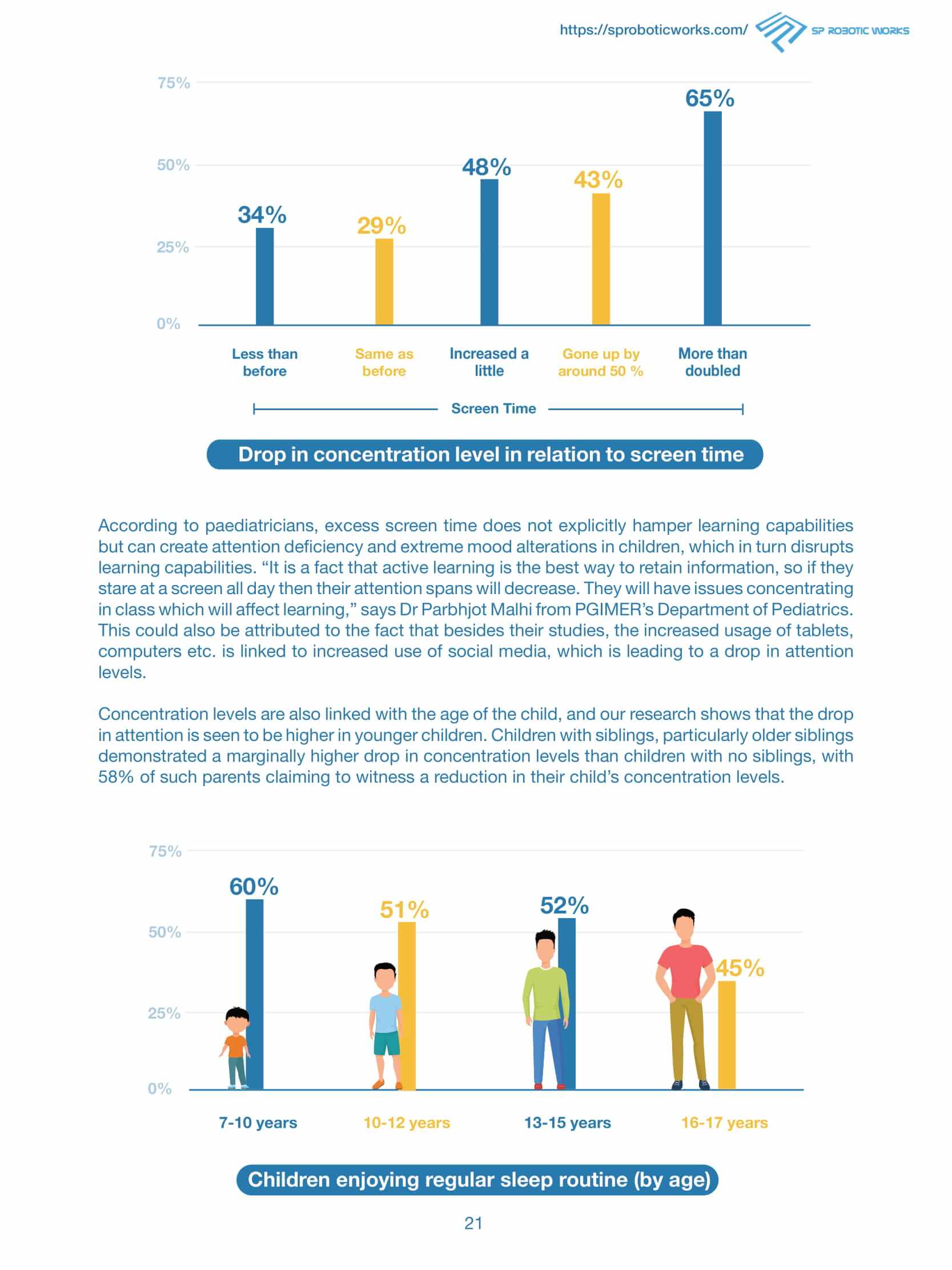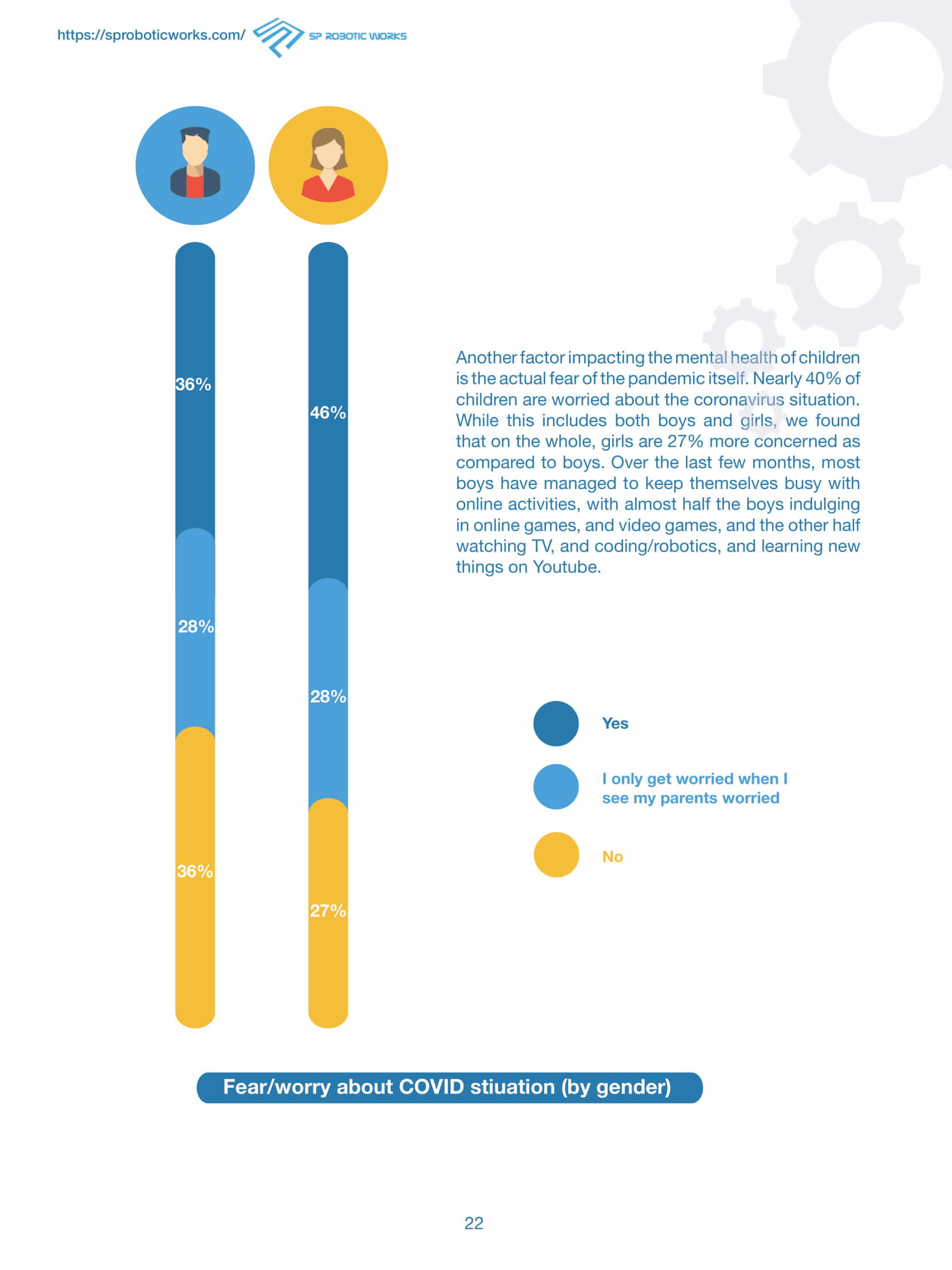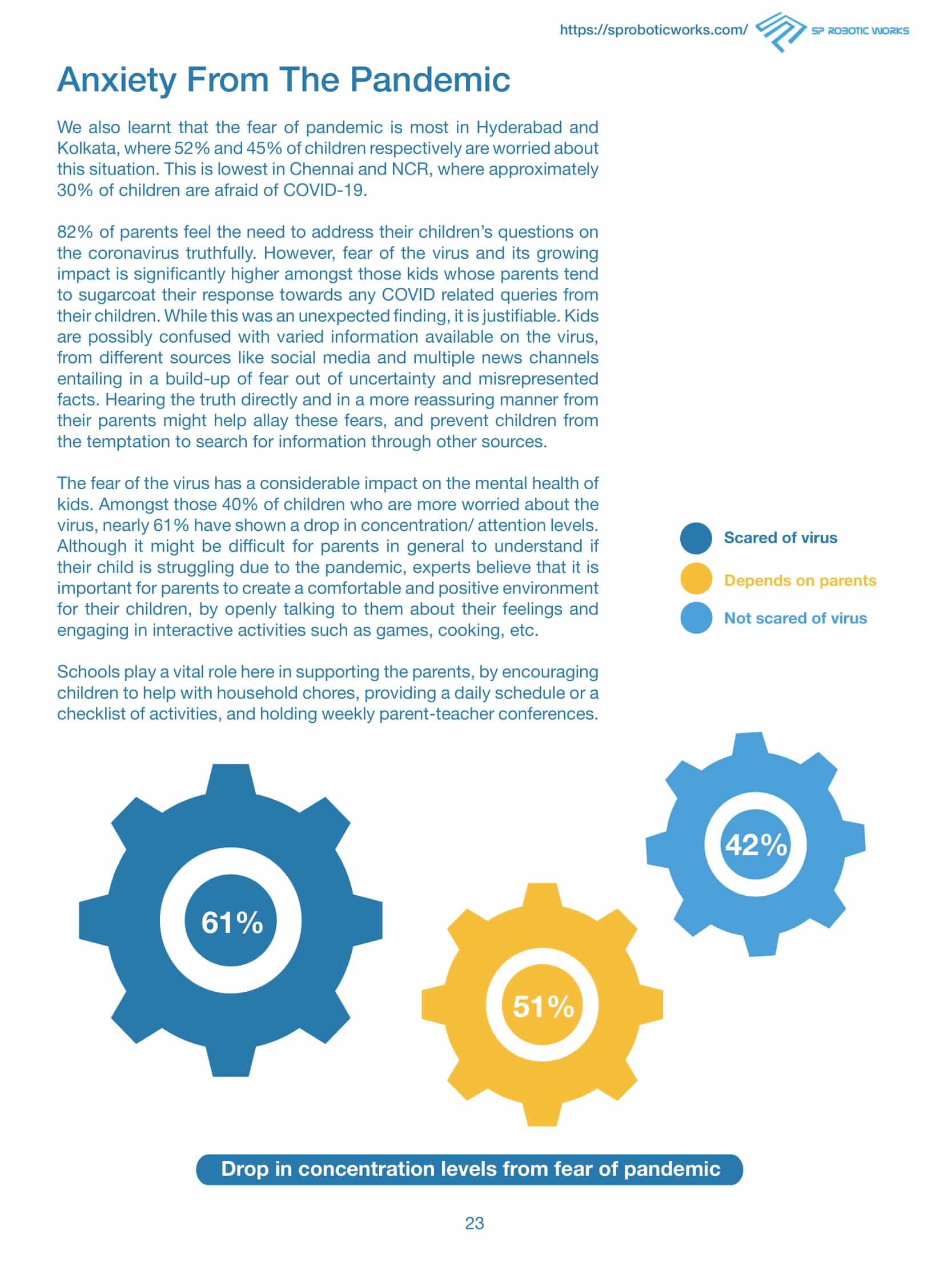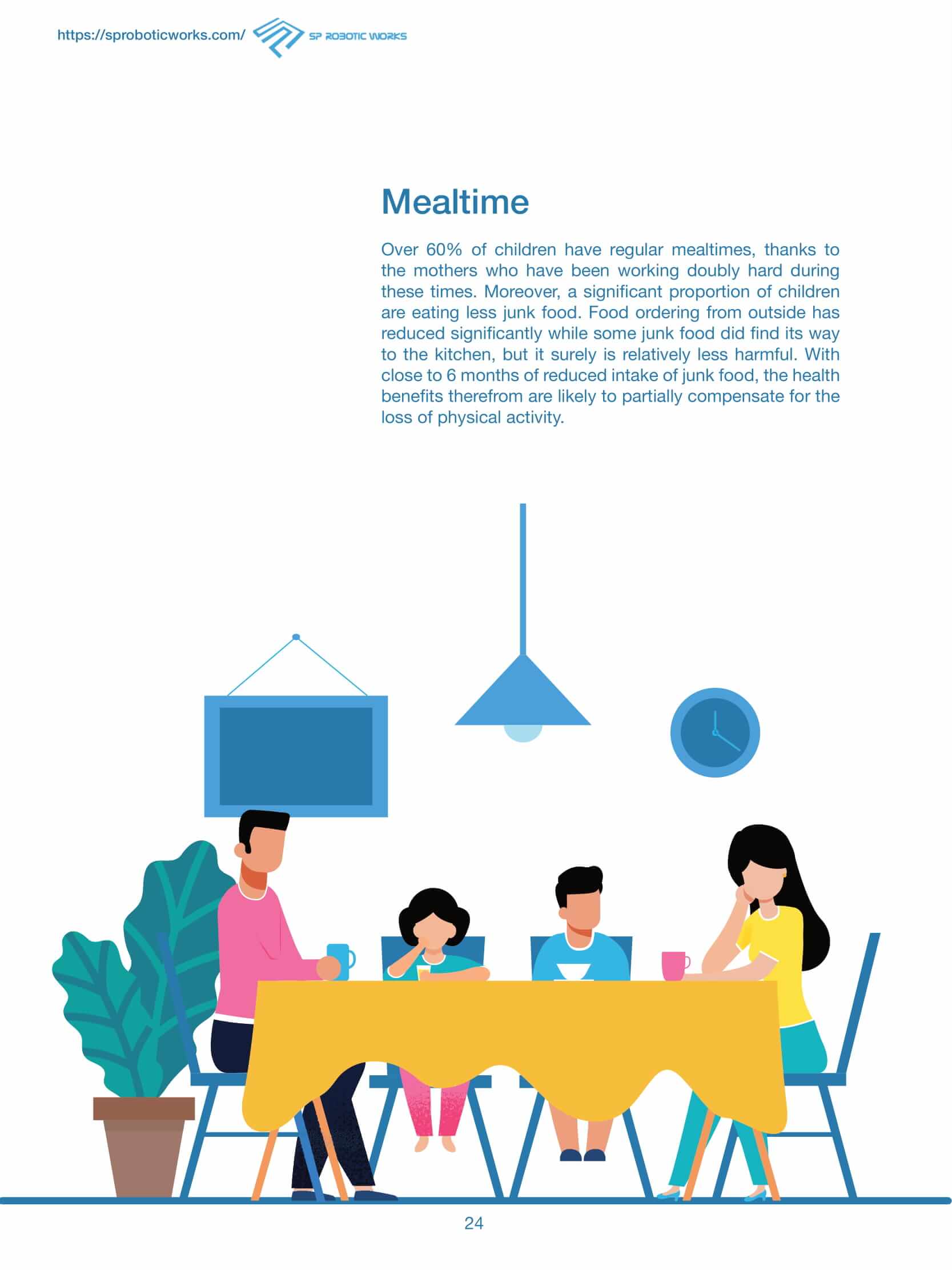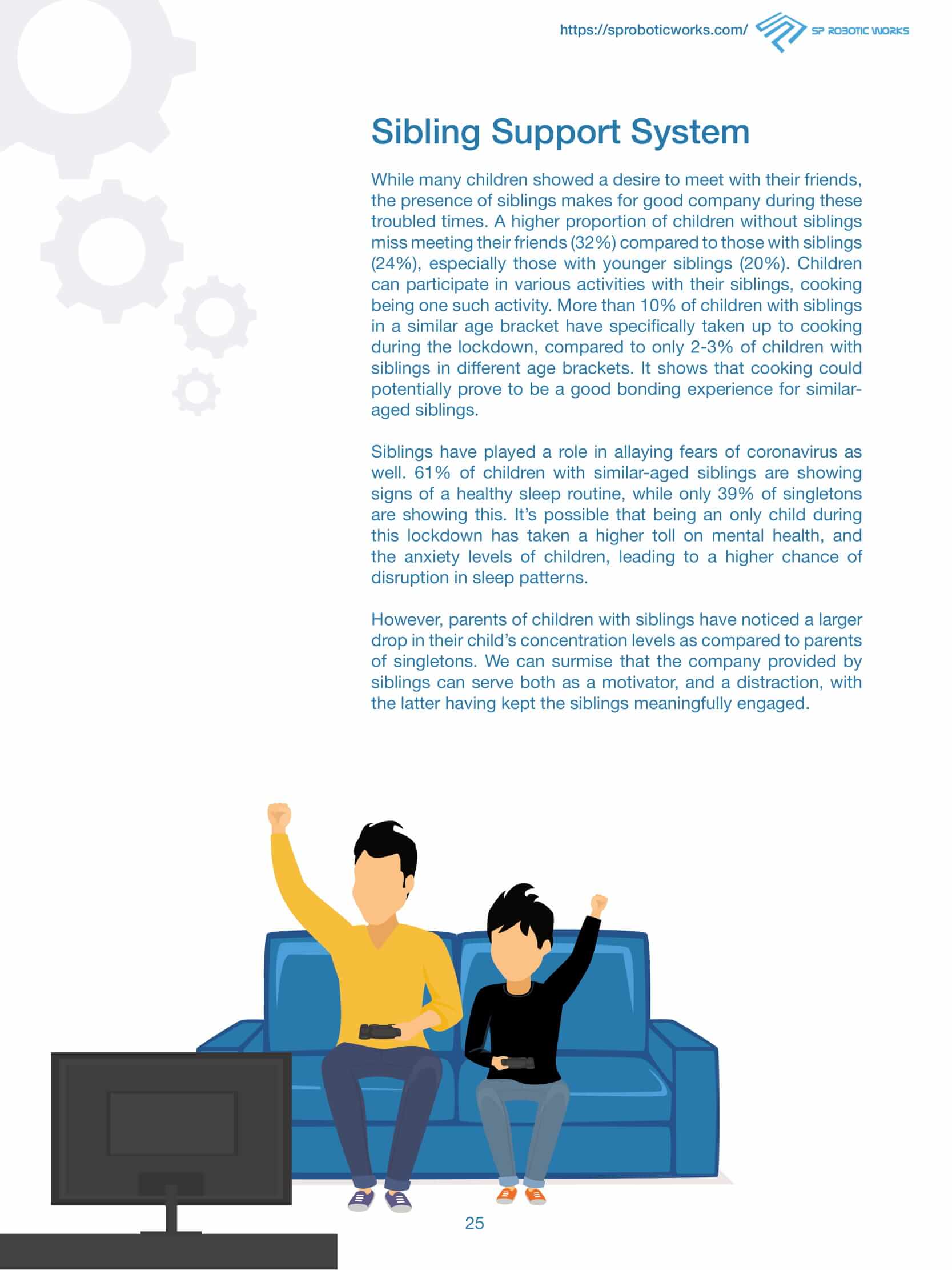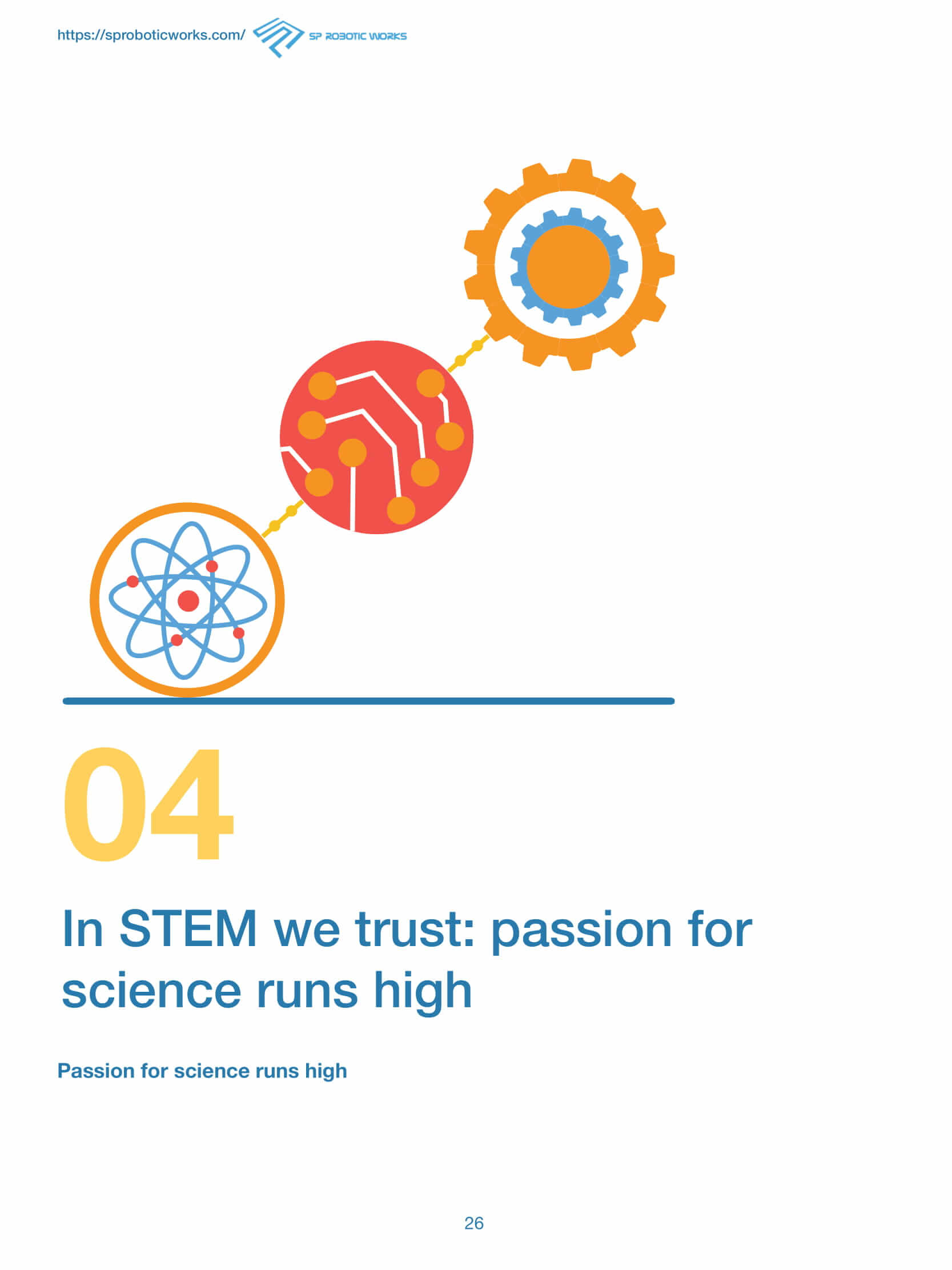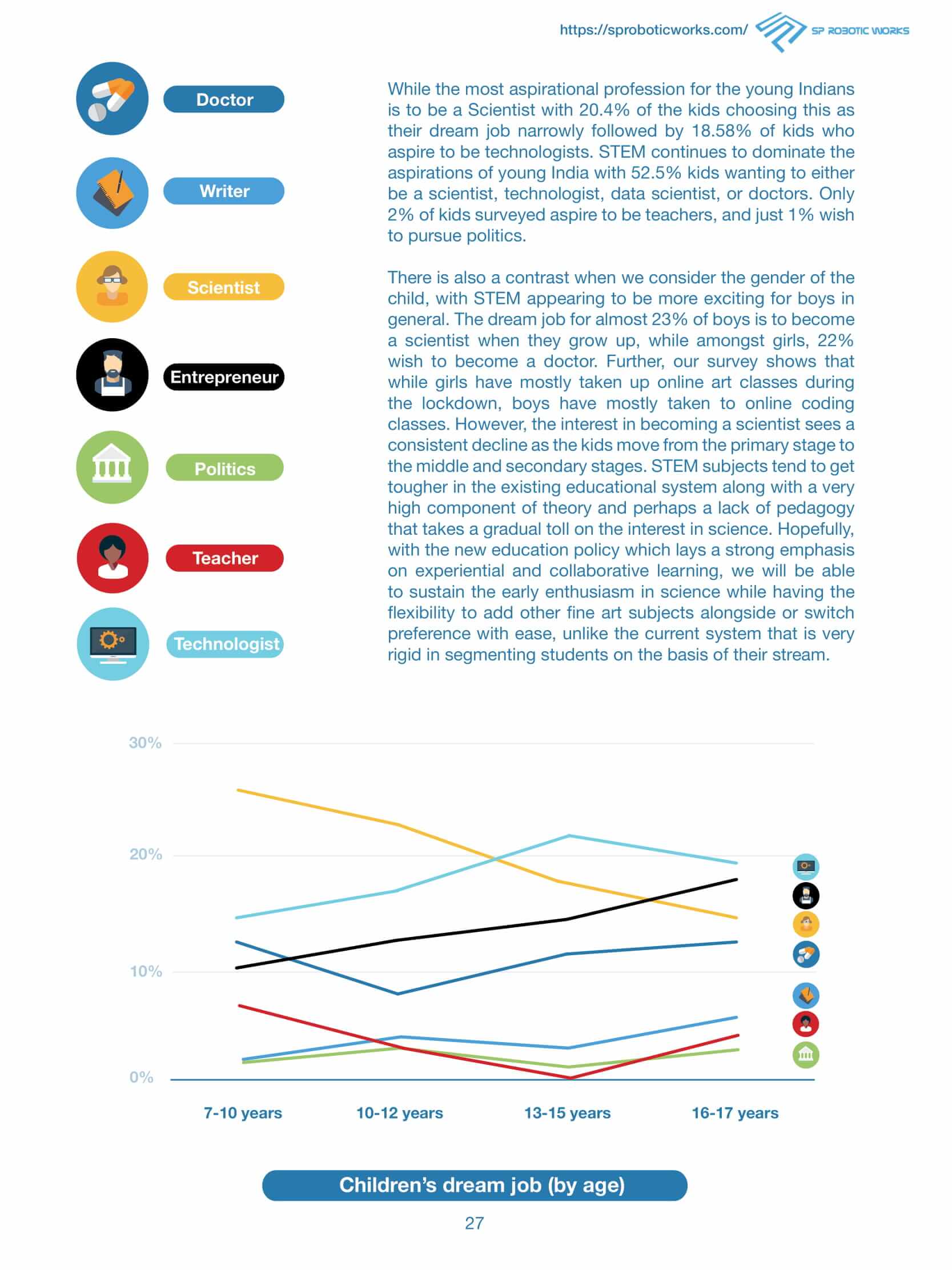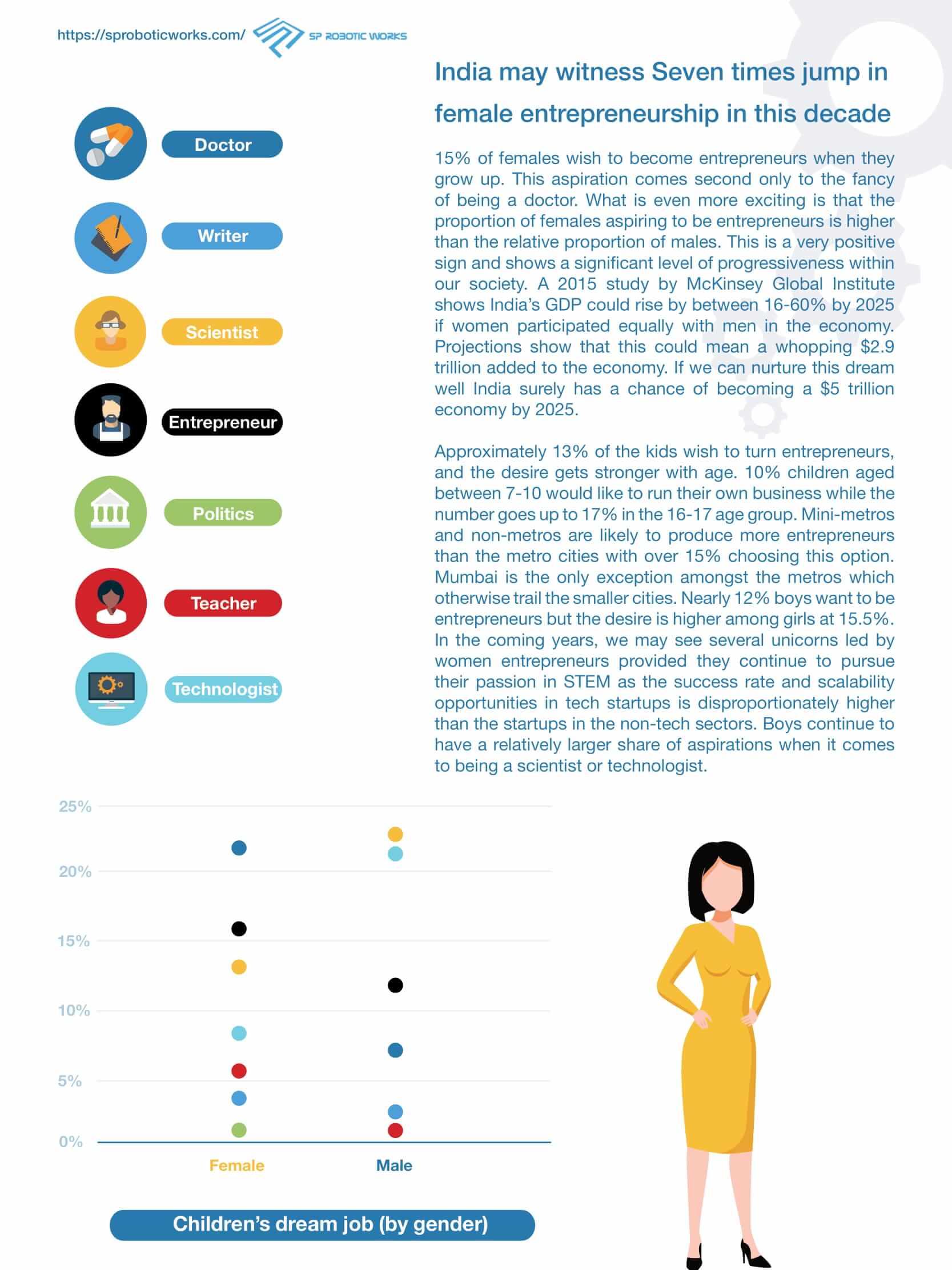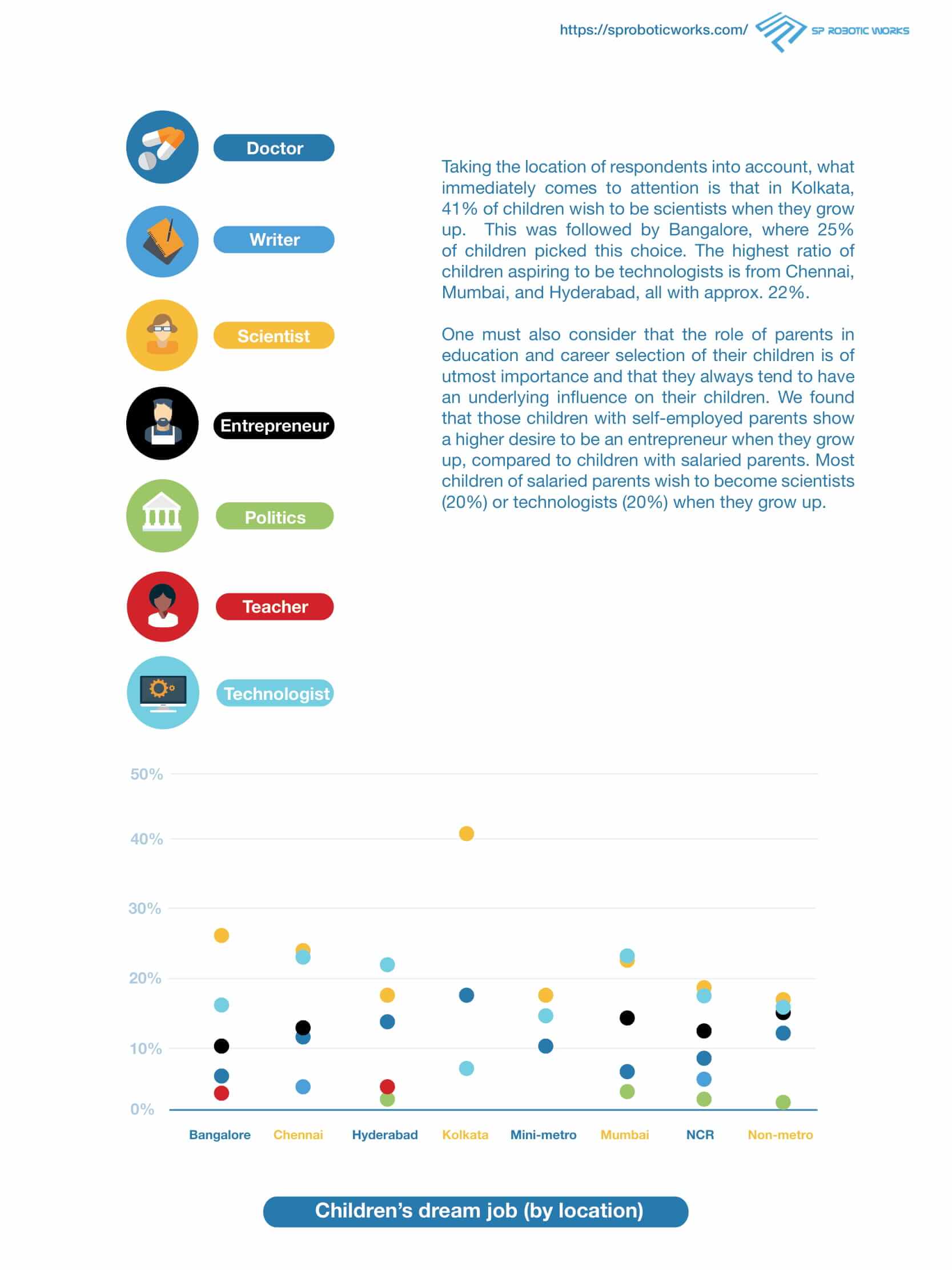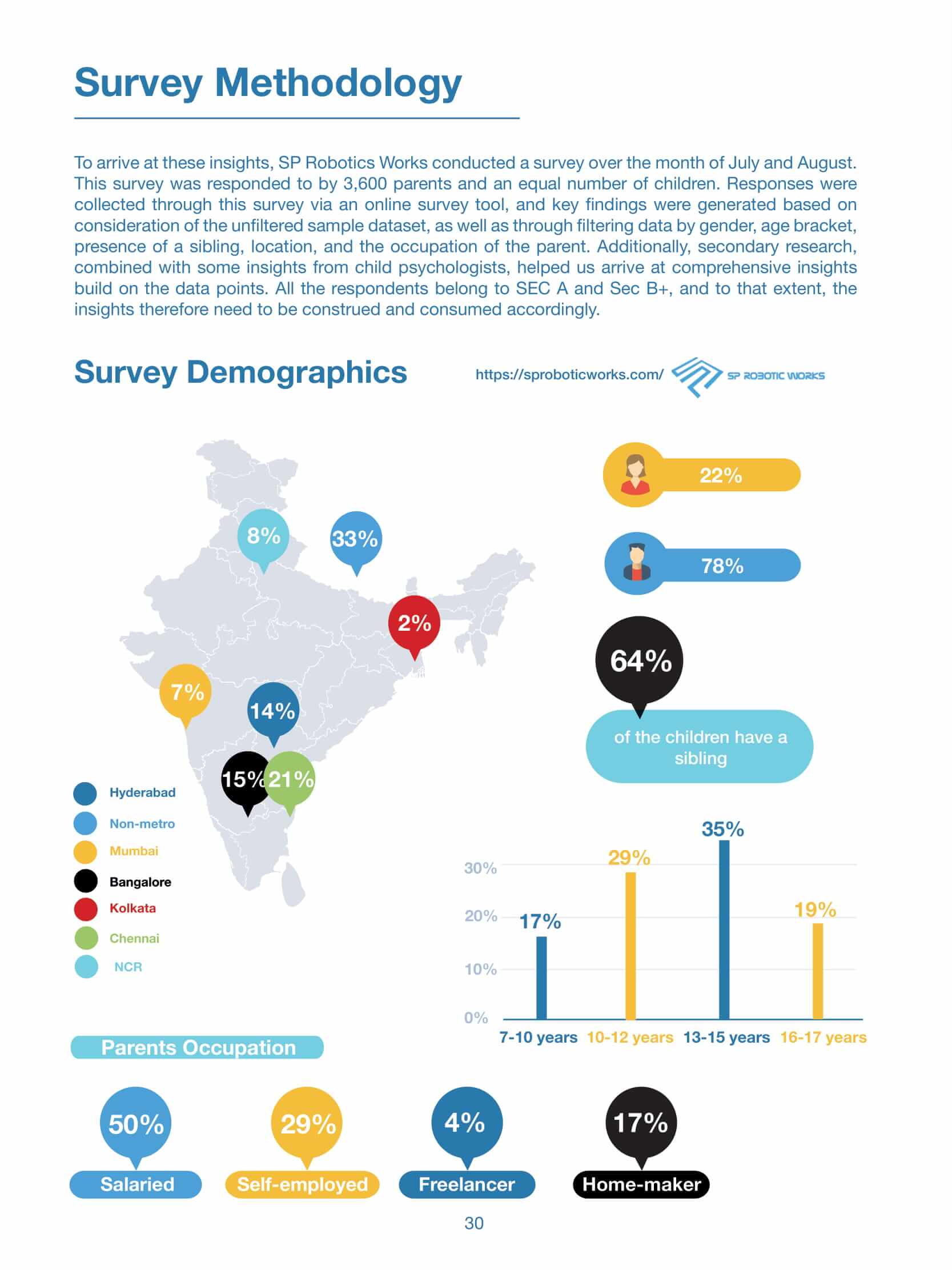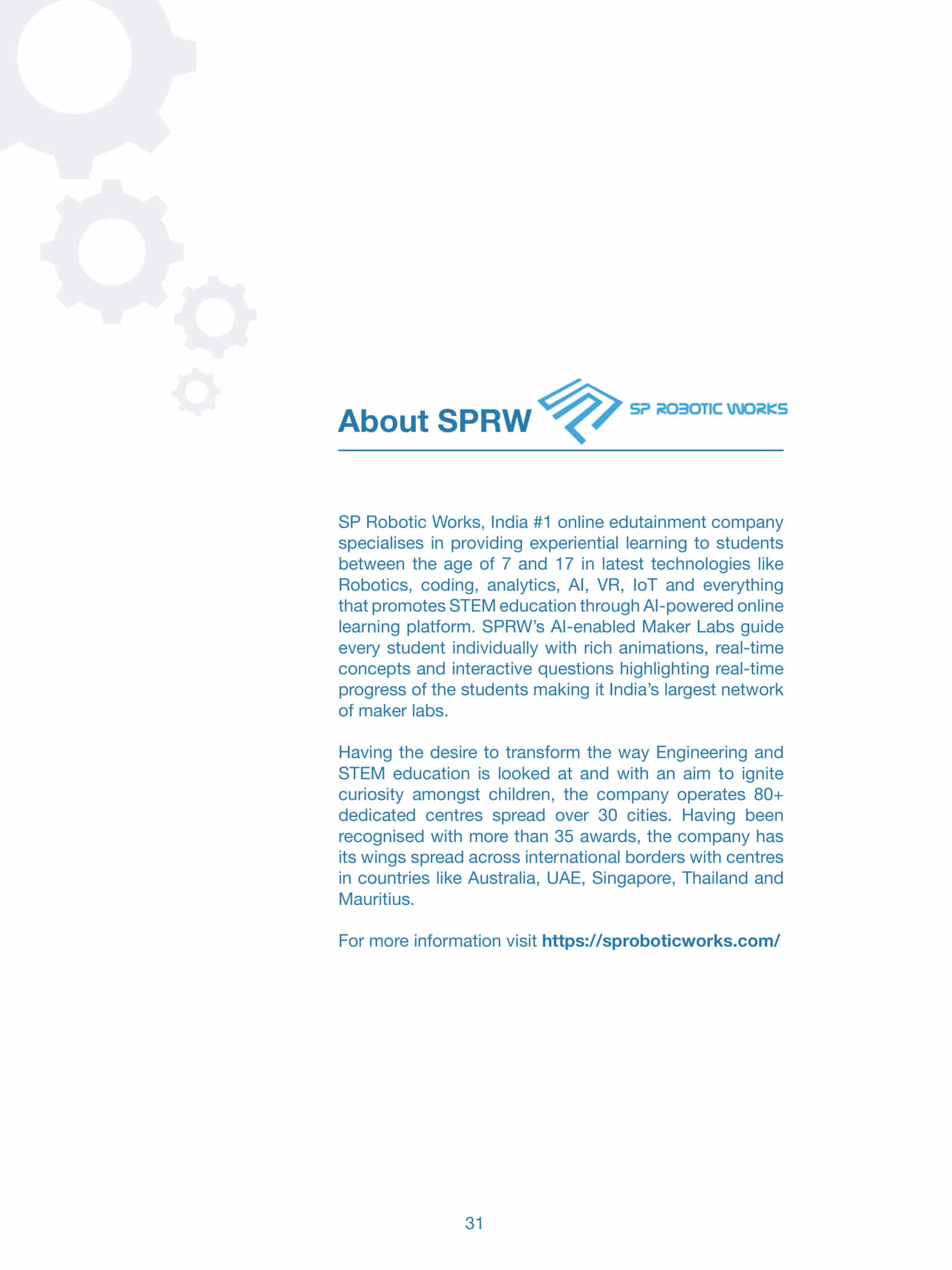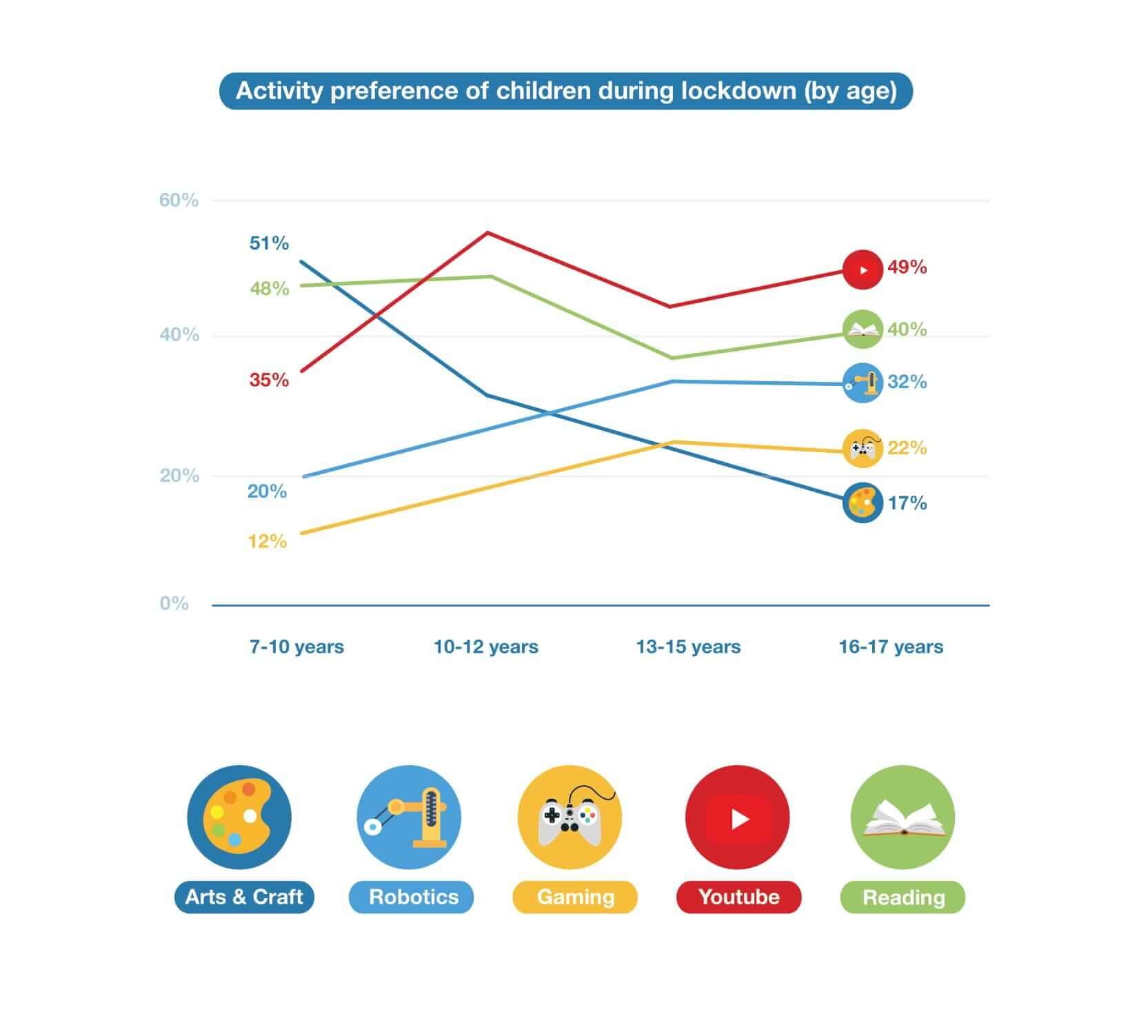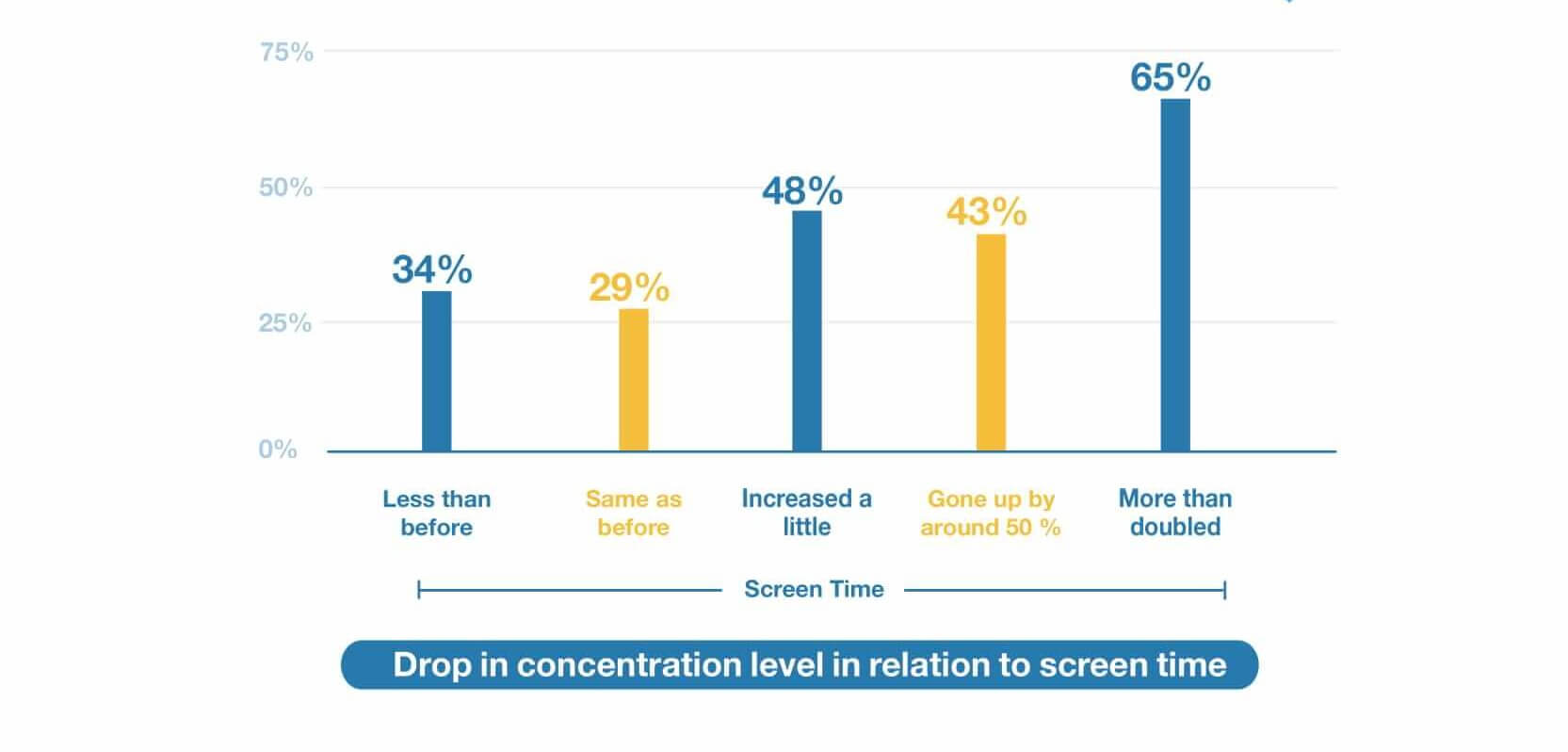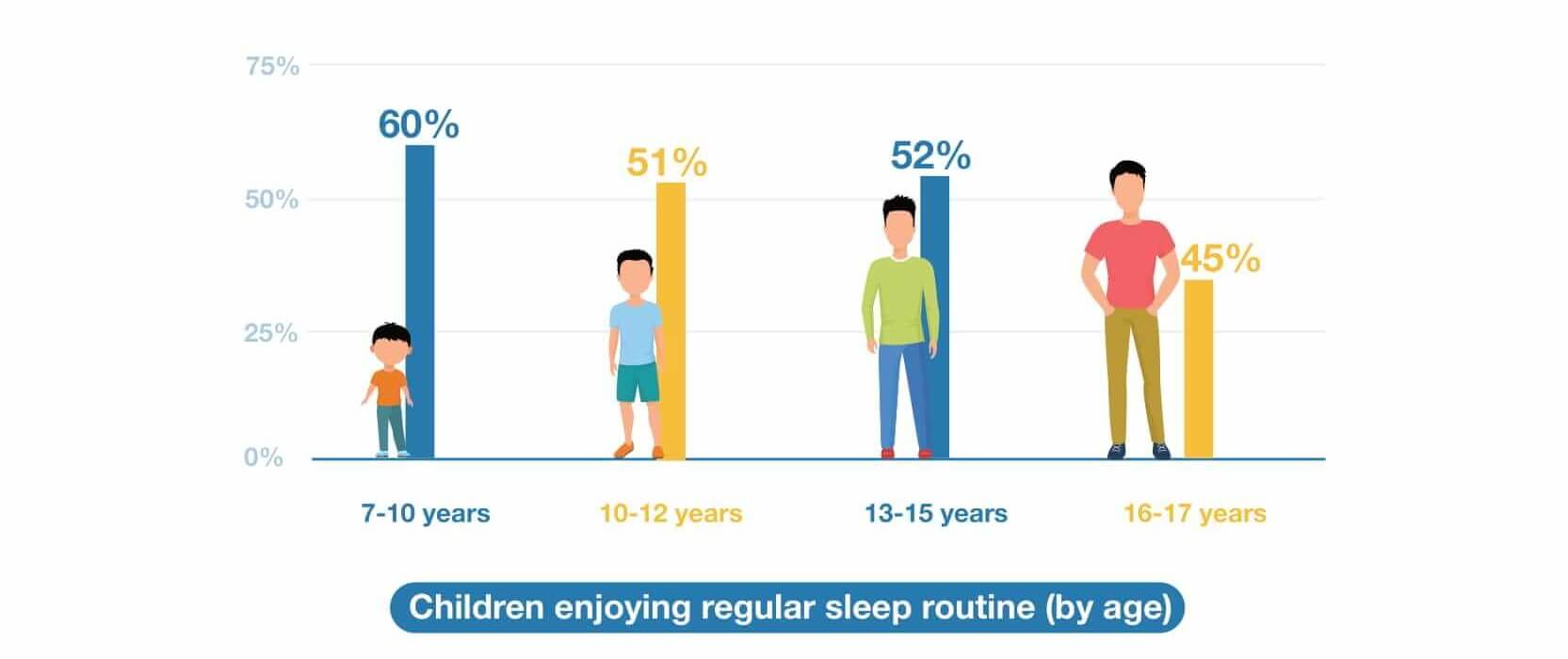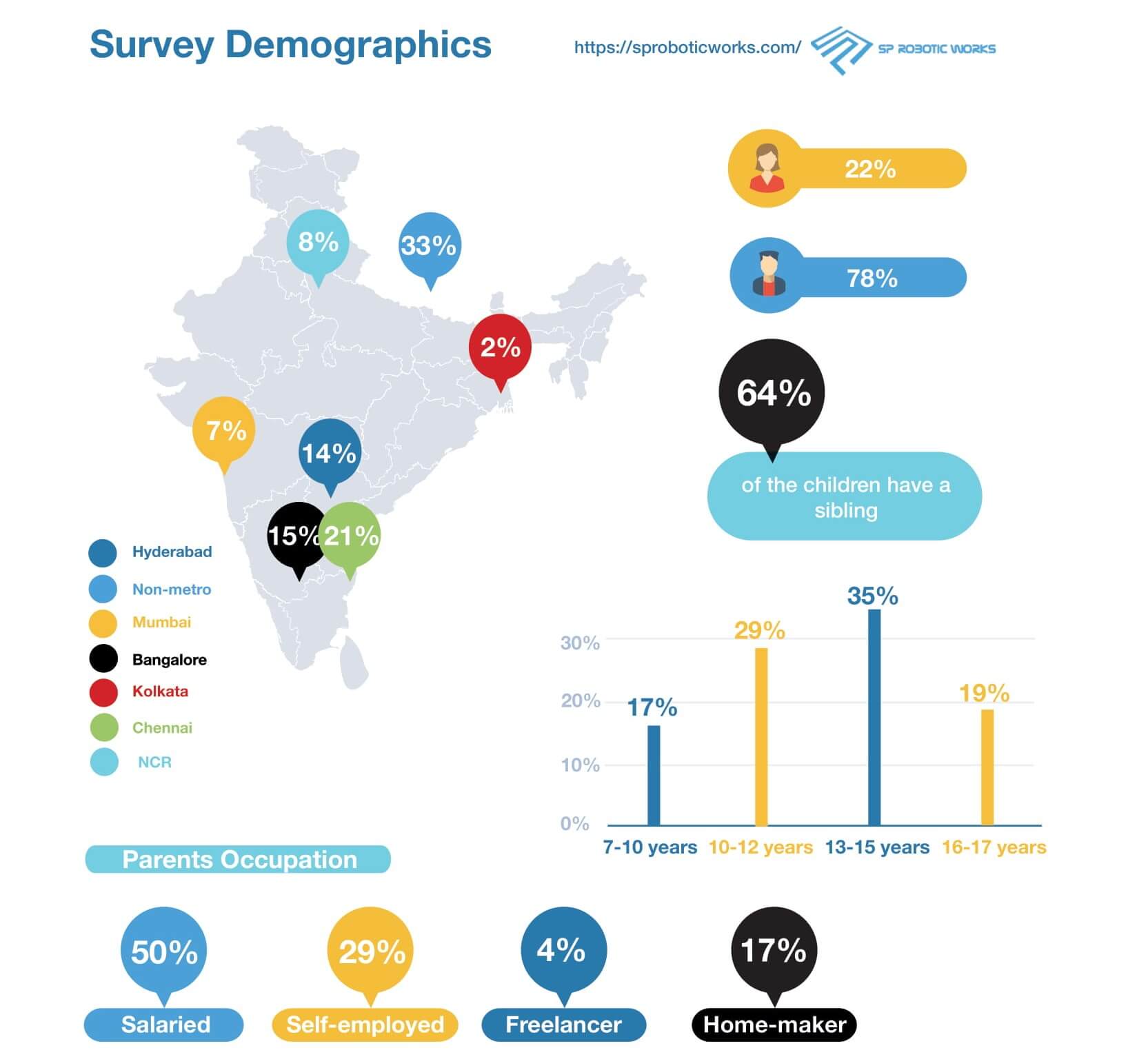
Contents
3 Foreword by Vidya Ragu
5 A note from the CEO
7 Key Insights
9 Chapter 1: Schooling during and post COVID
13 Chapter 2: Coding is in and toys are out
17 Chapter 3: The mental health of kids during lockdown
26 Chapter 4: In STEM we trust
30 Survey Methodology
31 About SPRW
https://sproboticworks.com/
Vidya Ragu
Foreword by a renowned Behavioural Scientist & Psychologist
Generally, when we quote ‘children’ and even as per national laws that define children ‘as humans under the age of 18’, we bracket all children of different age groups under the same category, assuming age to be binding & deciding factor. Whereas from a scientific view, the variation and contrast of developmental needs of different age groups is of utmost importance. Despite similar circumstances, the likings, interest, focus areas, experience, feelings, cognitive processes experienced by children amongst different age groups vary drastically. Thus the field of development psychology takes a keen interest in studying fine details about each age group separately and seeks to understand age-wise opportunity windows. These factors promote and hamper growth in children. Off late with the COVID situation, one of the most affected segments of our society are children who blossom and thrive with exploration, free movement and healthy social interaction, which has become a strict NO, owing to the pandemic leading to a build-up of stress and anxiety amongst many. So how are different age groups of children faring up in these unanticipated times? Many opinions and analysis are coming from adults, but nothing compares to the children’s direct insights
Most are indiscriminately calling online learning as the biggest boon. The whole world seems to promoting and pushing online content to children without much scientific view of how children learn and what they are experiencing. Having data-driven insights, like this survey, on how children of different age groups are coping up with the drastic changes and its impact on their mind becomes essential. Getting a peek into their world becomes very critical so we have the right understanding to make robust, wise, informed decisions as caregivers and educators.
The research captures a detailed compilation of the insights & experiences of key stakeholders – the school goers. At the same time, it gives an insight into the demographics, socio-economic aspects of parents (who are currently only adults who make up children’s environment). It’s a boon to have such studies and surveys that throw light on what is working and what’s not across age groups and different cities (metro, non-metros) and from diverse backgrounds of working, business or freelance career families.
The outcome of the research highlights the ability of children to adapt rapidly. It’s encouraging to see most children engaged in constructive learning and also to note the exciting connection of siblings as a vital factor for motivation/distraction, showcasing the need for design, discipline, routines balanced with healthy fun, bonding time as a family. While younger children enjoy creative, structured learning environments and social stimulus, they have found some solace with the boom of online art, activity classes. On the other hand, the elder children are motivated by the need for autonomy and enjoy intellectually stimulating conversations that nudged them to engage with the abundance of learning options on open source platforms, that are learner-driven like the ones available on Youtube.
While we understand coping with online classes is the new normal for children, the response from students in the survey reinforces the importance and preference for healthy, conducive social environments that promote learning & development in children of all age groups. There is an emphasis on the need for parents to design their work-life balance, quality time with children in the current times wherein there seem to be no borders with both work and family interactions spilling into each other under the same roof. The most encouraging factors revealed through the survey is the renewed interest in entrepreneurship and STEM (Science Technology Engineering & Maths) amongst children of both genders, metros and non-metros, which promises great potential for Future Young India.
Sneha Priya
A note from the CEO
Dear Parents,
The last 150 days have been unprecedented. Children have been unable to go to school, and in most parts of the country, have not even stepped out of their homes, to experience a normal day. While much has been said about the ensuing
wrath the pandemic unleashed on people, businesses and the economy, there is seemingly less consideration given to how it has impacted the bright young minds of the country.
This prolonged lockdown can potentially change some habits of the school-goers for life. Sedentary lifestyle, siloed learning, and a lack of social engagement can have a lifelong impact on the mental as well as the psychological well being of the children. Left with little choice, these school going children have had to resort to online classes to ensure they get to cover their syllabus on time. While this remains a luxury as many others would not have access to a suitable device, a stable internet connection and a dedicated corner at their home. The concentration levels are depleting, and sleep patterns have been impacted.
Parenting itself has been challenging during these times with parents moving their offices at home and juggling between the work and home boundaries has not been easy. Besides, the socio-economic challenges have made quality time a relative rarity. Parents who are worried about the pandemic and its consequential impact on their financial health can unintentionally have their children in a state of flux.
Platforms with experiential and interactive learning which engage children in practical tasks, logical reasoning have proven to be helpful during these times. While just watching a video on YouTube is passive engagement; however, learning how to play the guitar on YouTube is interactive learning. Many school goers have taken on new hobbies and are learning new skills, including coding and robotics. With the right interventions, parents can consciously guide their kids to engage in online activities with a fair amount of balance in passive and active learning. Engaging children on such interactive platforms at home can enhance children’s ability to think, understand, communicate, imagine and remember.
Well, all is not gloomy when it comes to the education system in India. The new education policy is likely to bring the much-required change to the education system that was otherwise tethered to textbooks and prioritised rote learning and exams. The NEP’s recommendations will give freedom to both students and teachers to step beyond the defined boundary and explore new forms of knowledge. Success in the knowledge era is contingent upon a strong STEM base. To address that, the NEP rightly stresses the importance of including experiential learning replacing the existing pedagogy of teaching maths in schools. The emphasis on open-ended questions that the NEP tries to promote will help build curiosity amongst students to understand the ‘whys’ and ‘hows’ instead of just the ‘whats’. A better conceptual understanding and experiential learning abets creativity and encourages children to think up elegant solutions to everyday problems using a multidisciplinary approach.
Another important recommendation of the NEP is about making coding compulsory in middle school. Our economy is heavily dependent on IT, especially in times of an unprecedented crisis that we are currently facing. This experience demands that it’s time we take this to the next step and prepare our children for the future. We at SP Robotic Works have been focusing on hands-on experiential learning for the kids alongside their school curriculum. We firmly believe that if implemented well the new regime will not only ignite curiosity at an early age it will also help in sustaining the imaginative mind beyond the initial years which otherwise was consumed in rote learning to secure marks irrespective of getting a good comprehension of the concepts and how they can be applied to solve the real-world challenges. This change in pedagogy will fuel innovation which is necessary to build an atmanirbhar Bharat
Key Insights
Lockdown has been hard on everyone, including the children. For most of us, outdoor activities were primarily motivated by our business and professional needs. At the same time, for children, it was their life, be it school, playground, cycling, running or simply being out with friends. For the younger kids, these are their formative years; missing out on physical activity and interaction with friends can compromise their growth, both physical and physiological. We conducted a detailed survey amongst 3,600 parents and their children (in the age group of 7-17, to analyse the collective answer from thousands of kids and parents, and thus highlight the key areas that need attention. Conversations with some select participants helped in understanding the outcomes from the survey better. And finally, the research findings have been deciphered by specialists like Vidya Ragu, a renowned child psychologist.
Parents ready to skip a year of schooling for their children
78% of the parents are unwilling to take any risks with their children when it comes to sending them to school. They are not likely to send their children to school even if the schools open until it becomes safe for the kids to go out.
Parents and students reject the current way of online schooling
64% of parents believe that going to the classroom is better for their child than online learning. Likewise, 67% of children have no appreciation for online school education. They would rather go out every day and learn amongst their friends and come alive with discussions. Is online learning the new normal?
More on online schooling | Page 9
Toys are out....Robots & Coding are in
At least 29% of the kids are learning coding/robotics on online platforms. Though the majority of children are missing outdoor activities, new interests and hobbies have taken over. The online school take up a good part of the day, read to know what other activities are keeping children engaged during the lockdown. More on activities that children are craving to do post lockdown and how having a sibling has been a blessing.
More on what’s in during the lockdown | Page 13
Loss in concentration and disturbed sleeping patterns hints at frustration amongst kids.
Children are also the recipients of stricter rules of isolation as education can wait. They are feeling the frustration of being confined to the four walls. Nearly 50% are experiencing disturbed sleeping patterns. Amongst the 40% who are scared of the situation, 61% have experienced a drop in concentration levels. A deep dive into the sleep routines, screen time, physical activity, concentration, food habits and more.
More on the mental health of the kids during the lockdown | Page 17
India may witness Seven times more women entrepreneurs in this decade
Majority of the children want to be scientists and technologists with passion acquired at quite a young age. Mini-metros and non-metros are likely to produce more entrepreneurs than the metro cities. Such a large ecosystem of startups in India has just 2% women as entrepreneurs. This is likely to change in the coming decade. While just 12% of boys want to be entrepreneurs in comparison close to 15.5% of the girls aspire to be entrepreneurs. In the coming years, we may see several unicorns led by women entrepreneurs
More on children’s aspirations | Page 26
01
Schooling during and post-COVID
Parents are ready to skip one year of schooling for the safety of their children.
78% of parents are not willing to send their children to school till the pandemic is over, and it is safe for them to step out, even if their children have to miss a year of school for their safety. The verdict from the parents is unequivocal. Until it becomes completely safe for children to step out, they are not willing to send them to school even if they have to repeat the class. The Education Ministry has already ruled out the possibility of declaring 2020-21 as a “zero academic year” due to the COVID outbreak during a recent meeting of the Parliamentary Standing Committee on Human Resource Development. Parents in Bangalore, Mumbai, Hyderabad, and mini- metros are even more concerned as between 82-86% are unwilling to take any risk with the children. Chennai and Kolkata are the only exceptions among the major cities where the ratio of parents that are willing to take chances with sending their children to school is higher than the national average.
Parents’ profession plays a significant role in their response. Salaried parents are the most protective, with only 17% willing to send their children to school as soon as the schools reopen. In contrast, 30% of self- employed and 56% of freelance workers are likely to send their children to school immediately after they open. The pandemic has undoubtedly taken a considerable toll on small business owners and gig workers than the salaried class as far as financial security is concerned. The response from different cohorts is also rooted in their appetite for risk and the need to explore other avenues of income during these turbulent times.
The unpredictability faced by this group of parents also has another repercussion, which is the willingness of parents to enrol their kids in extracurricular activities. More than 40% of self-employed/ freelance parents have not enrolled their children in any online extracurricular classes during this time, while only 17% of salaried parents have failed to do so.
86%
85%
84%
82%
70%
67%
Bangalore
Chennai
Hyderabad
Kolkata
Mini-metro
Mumbai
% of parents across India unwilling to send children to school
Parents and Kids reject the new normal of online classes
While there are studies that show online learning is an equally effective mode of education, it is certainly not desired by children or parents. Over two third of children prefer to learn in the classroom instead of online. Less than one-third of all children prefer online learning as compared to learning in the school.
It is worth noting that while online learning is generally not preferred by the majority, children, as well as the parents in smaller cities and non-metros, are more likely to prefer online learning compared to those in metros, with the exception of Bangalore. A possible reason for this could be the relatively poor schooling infrastructure in regular schools in the mini- metros and non-metros or the schools being very rigid in their pedagogy with little room for extra-curricular activities.
The culture capital of India cannot wait to swing back in action, more so as the festive season kicks in. In Kolkata, only 7% of respondents (children) prefer the concept of online learning to classroom learning. Children in Kolkata are surely missing the fun of learning at the school and their outdoor activities more than their counterparts in other cities. This trend is equally vocal amongst the parents in Kolkata.
Preference for online learning is highest for children in the youngest age bracket (7-10 years), with 35% choosing online learning over classroom learning. In another interesting revelation, 74% of female children would prefer to learn in a classroom as compared to 65% of male children.
Bangalore
Chennai
Hyderabad
Kolkata
Mini-metro
Mumbai
NCR
Non-metro
62%
67%
77%
93%
56%
78%
67%
62%
66%
70%
68%
78%
56%
71%
56%
55%
Children
12
Parents
Majority of children & parents prefer in school classes
While there were many similarities in how children and parents think we also noticed a significant number of cases of disagreement. Out of the one-third children who preferred online learning, 41% of their respective parents believe that the classroom is better, while only 37% of parents were in agreement. The remaining parents claimed to be indifferent.
02
Coding is in, and toys are out
Active learning, even if it’s online is good for children
STEM plays a crucial role in the minds of parents who are enrolling their children into online classes. 23% of parents have engaged their children in an online robotics class during the lockdown period, while 32% have engaged them in an online coding class. According to the National Science Foundation, 80% of the jobs in the next decade will demand science and math skills. Children who embrace technology in middle school will surely have an advantage over the others and parents seem to be well aware of this.
Activity preference of children during lockdown (by age)
42% of children in Mumbai have been engaged in robotics/ coding activities during the lockdown, more than in any other city. This was a surprising observation as we were expecting Chennai and Bangalore to be leading this segment
55% of children have spent time learning new things on Youtube. However, Youtube as an engagement activity is preferred mostly in smaller metros, with 64% choosing this option. Bangalore steals the show when it comes to reading books, a relatively dying habit, with 54% children indulging in it. 34% of them spent their time cooking. Practising a musical instrument is most preferred in Kolkata (30%), while cooking is hardly an activity of preference there (only 7% picked this). Interestingly, video and app games are also preferred most in the smaller metros, with 26% keeping themselves busy playing online games.
While it’s not surprising to discover that one third of the kids have near-zero physical activity, the consequences of this sedentary lifestyle change can have long term implications on growth and vulnerability to obesity. Only 32% of the children have been indulging in proactive physical engagement during the lockdown. On the other hand, 36% of the kids who had to support their parents in accomplishing the household chores got a chance of their lifetime to learn life skills including cleaning, cooking and washing. It’s important for parents to ensure that the kids are being motivated to engage in indoor physical activities until there is the freedom to go back to our usual routine.
Everyone is keen to step outside as soon as it’s safe for them. However, the choice of first outdoor activity differs amongst age groups, with many of the younger children aged 7-12 wishing to play sports compared to children aged 16-17—the older cohort keener to eat out and travel during holiday.
Help parents with household chores
Indoor Exercises
No activity
32.4 %
33.9%
31.7%
Physical Activity during Lockdown
03
The mental health of the kids during the lockdown
Parents need to keep a close watch and moniter changing patterns of sleep, screen time and concentration levels.
Kids rarely share their state of wellbeing with anyone, and may not understand the meaning or feeling of depression. The only way to comprehend the mental wellbeing of the kids is by observing their behaviour and deviation from set patterns. The survey captures the noticeable change in behaviour and habits to decipher the mental well being of school going children. Given their dependency on the parents, parents play a significant role in keeping them meaningfully engaged as well as truthfully informed.
A majority of parents feel that their children’s routine has not been affected dramatically during the pandemic. With the sudden migration to online classes and digital engagement, they have not had much of a choice, but to adjust and adapt to their ‘new normal’. Here, YouTube has been amongst the most widely and frequently used channels of ‘edutainment’
Sleep
The sleeping pattern of nearly 50% of the kids has been disturbed with 13% kids having no regular pattern of sleeping. 45% of respondents suggest that their children are following a normal sleep routine. However, one-third of them observed a drastic shift in sleep patterns. Perhaps the majority of parents are enforcing strict methods as a disciplinary measure, despite having been in a lockdown situation. Children with siblings in a similar age group have seen the least impact on their sleeping pattern with over 61% sticking to the routine sleeping habits. Those with younger siblings usually sleep late as late hours seemingly might be their time with friends on virtual channels. The age group of 16-17 are thus experiencing the most irregular sleeping patterns, including late nights. Most children in this age group are most likely to be indulging in virtual house parties and Television/Films.
13%
45%
8%
34%
No proper sleep routine
Normal Routine
Sleep early and wake up
very early
Sleep late and wake up late
Sleep routine during lockdown (as observed by parents)
However, as expected, older children are more likely to experience a lack of sleep routine during this lockdown than younger children, and children in metros have a higher tendency to eat junk food, than children in non-metros. Routines are likely to get disturbed. Parents must ensure that children are getting adequate and continuous sleep even if the sleep cycle has been altered. If this is not the case then it is important to observe other changes to assess their overall mental wellbeing.
Screen Time
Another critical factor to consider in the child’s daily routine is the amount of time spent on the screen(s), and how this has changed under COVID-19. Many parents felt that their children’s screen time during this time has gone up significantly. 67% of parents think that their child’s screen time has gone up by at least 50% during the lockdown. Time spent on the screen has also increased by an even higher percentage for singletons than for those with siblings. This is a cause for concern, as one of the key side-effects of screen time is obesity caused due to inactivity, lack of movement, and indulging in unhealthy foods. Every hour spent on smartphone, tablet, computer or television increases the risk of obesity by 2x. Furthermore, close exposure to the screen can also lead to a risk of Myopia, particularly when combined with a lack of outdoor activity
Hyderabad and Mumbai kids take the lead here with more than 50% kids in these two cities have more than doubled their usage of screens while in Kolkata this number is as low as 15%. Boys who doubled their screen times surpass girls by 26% in that category.
Screen time also has major repercussions on mental health and is also directly linked with the child’s concentration levels. This trend is highest amongst the kids whose screen time has more than doubled, showing a 123% decrease in concentration levels as compared to the kids with no change in their screen time consumption patterns. A higher proportion of those children showing an increase in screen time have also faced a disruption in their sleep routines. Besides, kids with high screen time show 100% increase in sleep disorder
Passive engagement with the screen for a prolonged period can have severe consequences on a child’s cognitive development. With schools unlikely to resume in the immediate future, the holistic development of children is undoubtedly an area of worry for most parents. Hence it is crucial for a child to indulge in “interactive screen time” to keep the learning curve progressive, with new skills and learnings being inculcated in a creative manner. Platforms with experiential and interactive learning which engage children in practical tasks, logical reasoning have proven to be helpful during these times
Children from Mumbai have shown the sharpest increase in screen time, with more than 75% of parents claiming that their child’s screen time has gone up by at least 50%
Screen time has risen the most for children aged 10-15, where approx. 75% of children have shown a significant rise in screen time
According to paediatricians, excess screen time does not explicitly hamper learning capabilities but can create attention deficiency and extreme mood alterations in children, which in turn disrupts learning capabilities. “It is a fact that active learning is the best way to retain information, so if they stare at a screen all day then their attention spans will decrease. They will have issues concentrating in class which will affect learning,” says Dr Parbhjot Malhi from PGIMER’s Department of Pediatrics. This could also be attributed to the fact that besides their studies, the increased usage of tablets, computers etc. is linked to increased use of social media, which is leading to a drop in attention levels.
Concentration levels are also linked with the age of the child, and our research shows that the drop in attention is seen to be higher in younger children. Children with siblings, particularly older siblings demonstrated a marginally higher drop in concentration levels than children with no siblings, with 58% of such parents claiming to witness a reduction in their child’s concentration levels.
Another factor impacting the mental health of children is the actual fear of the pandemic itself. Nearly 40% of children are worried about the coronavirus situation. While this includes both boys and girls, we found that on the whole, girls are 27% more concerned as compared to boys. Over the last few months, most boys have managed to keep themselves busy with online activities, with almost half the boys indulging in online games, and video games, and the other half watching TV, and coding/robotics, and learning new things on Youtube.
36%
28%
36%
46%
28%
27%
Fear/worry about COVID stiuation (by gender)
Yes
I only get worried when I see my parents worried
No
Anxiety From The Pandemic
We also learnt that the fear of pandemic is most in Hyderabad and Kolkata, where 52% and 45% of children respectively are worried about this situation. This is lowest in Chennai and NCR, where approximately 30% of children are afraid of COVID-19
82% of parents feel the need to address their children’s questions on the coronavirus truthfully. However, fear of the virus and its growing impact is significantly higher amongst those kids whose parents tend to sugarcoat their response towards any COVID related queries from their children. While this was an unexpected finding, it is justifiable. Kids are possibly confused with varied information available on the virus, from different sources like social media and multiple news channels entailing in a build-up of fear out of uncertainty and misrepresented facts. Hearing the truth directly and in a more reassuring manner from their parents might help allay these fears, and prevent children from the temptation to search for information through other sources.
The fear of the virus has a considerable impact on the mental health of kids. Amongst those 40% of children who are more worried about the virus, nearly 61% have shown a drop in concentration/ attention levels. Although it might be difficult for parents in general to understand if their child is struggling due to the pandemic, experts believe that it is important for parents to create a comfortable and positive environment for their children, by openly talking to them about their feelings and engaging in interactive activities such as games, cooking, etc.
Schools play a vital role here in supporting the parents, by encouraging children to help with household chores, providing a daily schedule or a checklist of activities, and holding weekly parent-teacher conferences.
Drop in concentration levels from fear of pandemic
61%
51%
42%
Scared of virus
Depends on parents
Not scared of virus
Mealtime
Over 60% of children have regular mealtimes, thanks to the mothers who have been working doubly hard during these times. Moreover, a significant proportion of children are eating less junk food. Food ordering from outside has reduced significantly while some junk food did find its way to the kitchen, but it surely is relatively less harmful. With close to 6 months of reduced intake of junk food, the health benefits therefrom are likely to partially compensate for the loss of physical activity.
Sibling Support System
While many children showed a desire to meet with their friends, the presence of siblings makes for good company during these troubled times. A higher proportion of children without siblings miss meeting their friends (32%) compared to those with siblings (24%), especially those with younger siblings (20%). Children can participate in various activities with their siblings, cooking being one such activity. More than 10% of children with siblings in a similar age bracket have specifically taken up to cooking during the lockdown, compared to only 2-3% of children with siblings in different age brackets. It shows that cooking could potentially prove to be a good bonding experience for similar- aged siblings.
Siblings have played a role in allaying fears of coronavirus as well. 61% of children with similar-aged siblings are showing signs of a healthy sleep routine, while only 39% of singletons are showing this. It’s possible that being an only child during this lockdown has taken a higher toll on mental health, and the anxiety levels of children, leading to a higher chance of disruption in sleep patterns
However, parents of children with siblings have noticed a larger drop in their child’s concentration levels as compared to parents of singletons. We can surmise that the company provided by siblings can serve both as a motivator, and a distraction, with the latter having kept the siblings meaningfully engaged.
04
In STEM we trust: passion for science runs high
Passion for science runs high
While the most aspirational profession for the young Indians is to be a Scientist with 20.4% of the kids choosing this as their dream job narrowly followed by 18.58% of kids who aspire to be technologists. STEM continues to dominate the aspirations of young India with 52.5% kids wanting to either be a scientist, technologist, data scientist, or doctors. Only 2% of kids surveyed aspire to be teachers, and just 1% wish to pursue politics.
There is also a contrast when we consider the gender of the child, with STEM appearing to be more exciting for boys in general. The dream job for almost 23% of boys is to become a scientist when they grow up, while amongst girls, 22% wish to become a doctor. Further, our survey shows that while girls have mostly taken up online art classes during the lockdown, boys have mostly taken to online coding classes. However, the interest in becoming a scientist sees a consistent decline as the kids move from the primary stage to the middle and secondary stages. STEM subjects tend to get tougher in the existing educational system along with a very high component of theory and perhaps a lack of pedagogy that takes a gradual toll on the interest in science. Hopefully, with the new education policy which lays a strong emphasis on experiential and collaborative learning, we will be able to sustain the early enthusiasm in science while having the flexibility to add other fine art subjects alongside or switch preference with ease, unlike the current system that is very rigid in segmenting students on the basis of their stream.
Doctor
Scientist
Writer
Teacher
Politics
7-10 years
10-12 years
13-15 years
16-17 years
0%
10%
20%
30%
Children’s dream job (by age)
Entrepreneur
Technologist
India may witness Seven times jump in
female entrepreneurship in this decade
15% of females wish to become entrepreneurs when they grow up. This aspiration comes second only to the fancy of being a doctor. What is even more exciting is that the proportion of females aspiring to be entrepreneurs is higher than the relative proportion of males. This is a very positive sign and shows a significant level of progressiveness within our society. A 2015 study by McKinsey Global Institute shows India’s GDP could rise by between 16-60% by 2025 if women participated equally with men in the economy. Projections show that this could mean a whopping $2.9 trillion added to the economy. If we can nurture this dream well India surely has a chance of becoming a $5 trillion economy by 2025
Approximately 13% of the kids wish to turn entrepreneurs, and the desire gets stronger with age. 10% children aged between 7-10 would like to run their own business while the number goes up to 17% in the 16-17 age group. Mini-metros and non-metros are likely to produce more entrepreneurs than the metro cities with over 15% choosing this option. Mumbai is the only exception amongst the metros which otherwise trail the smaller cities. Nearly 12% boys want to be entrepreneurs but the desire is higher among girls at 15.5%. In the coming years, we may see several unicorns led by women entrepreneurs provided they continue to pursue their passion in STEM as the success rate and scalability opportunities in tech startups is disproportionately higher than the startups in the non-tech sectors. Boys continue to have a relatively larger share of aspirations when it comes to being a scientist or technologist.
0%
5%
10%
15%
Male
Female
20%
Doctor
Scientist
Writer
Teacher
Politics
Entrepreneur
Technologist
25%
Children’s dream job (by gender)
Taking the location of respondents into account, what immediately comes to attention is that in Kolkata, 41% of children wish to be scientists when they grow up. This was followed by Bangalore, where 25% of children picked this choice. The highest ratio of children aspiring to be technologists is from Chennai, Mumbai, and Hyderabad, all with approx. 22%.
One must also consider that the role of parents in education and career selection of their children is of utmost importance and that they always tend to have an underlying influence on their children. We found that those children with self-employed parents show a higher desire to be an entrepreneur when they grow up, compared to children with salaried parents. Most children of salaried parents wish to become scientists (20%) or technologists (20%) when they grow up.
0%
10%
20%
30%
40%
50%
Children’s dream job (by location)
Doctor
Scientist
Writer
Teacher
Politics
Entrepreneur
Technologist
Bangalore
Chennai
Hyderabad
Kolkata
Mini-metro
Mumbai
NCR
Non-metro
Survey Methodology
To arrive at these insights, SP Robotics Works conducted a survey over the month of July and August. This survey was responded to by 3,600 parents and an equal number of children. Responses were collected through this survey via an online survey tool, and key findings were generated based on consideration of the unfiltered sample dataset, as well as through filtering data by gender, age bracket, presence of a sibling, location, and the occupation of the parent. Additionally, secondary research, combined with some insights from child psychologists, helped us arrive at comprehensive insights build on the data points. All the respondents belong to SEC A and Sec B+, and to that extent, the insights therefore need to be construed and consumed accordingly.
About SPRW
SP Robotic Works, India #1 online edutainment company specialises in providing experiential learning to students between the age of 7 and 17 in latest technologies like Robotics, coding, analytics, AI, VR, IoT and everything that promotes STEM education through AI-powered online learning platform. SPRW’s AI-enabled Maker Labs guide every student individually with rich animations, real-time concepts and interactive questions highlighting real-time progress of the students making it India’s largest network of maker labs.
Having the desire to transform the way Engineering and STEM education is looked at and with an aim to ignite curiosity amongst children, the company operates 80+ dedicated centres spread over 30 cities. Having been recognised with more than 35 awards, the company has its wings spread across international borders with centres in countries like Australia, UAE, Singapore, Thailand and Mauritius
